Is the Catholic Church Becoming
a Branch of the Synagogue?
a Branch of the Synagogue?
Atila Sinke Guimarães
This analysis of John Paul II’s visit to the synagogue of Rome on April 13, 1986 is taken from the non-published volume III of my 11-volume collection on Vatican II, Eli Eli, Lamma Sabacthani?. Given that Benedict XVI will visit the synagogue of Cologne this August, it seemed to me that these considerations on the 1986 visit could provide my readers with some general lines that will probably also apply to the 2005 visit.
1. The symbolic-theological character of the visit
John Paul II’s visit to the Jewsih synagogue of Rome had a character that was substantially theological and should not be viewed as a merely "pastoral" act, as some would like to present it in order to attenuate its gravity. Fr. Giuseppe de Rosa, S.J., affirmed its theological importance in an article in La Civiltà Cattolica commenting on the event:
“The Pope’s meeting with the Hebrew community of Rome – which in some way represented all the Hebrew communities in the world, at least symbolically – has not only a ‘human’ content but also an actual ‘theological’ one. It was the recognition – or better, the confirmation, 20 years after Vatican II – of the ‘turnaround’ worked by the Council regarding the Church’s theological approach to Judaism.” (1)With the symbolic theological visit, John Paul II clearly broke the tradition of the Holy Church on treatment toward the Jewish religion. Quoting the Pontiff’s speech delivered in the Hebrew temple, a commentator of La Civiltà Cattolica said exactly this:
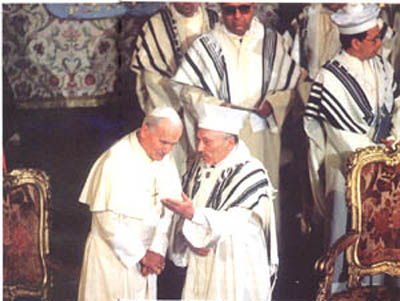 Inside the synagogue, JPII bows his head to hear the words of rabbi ToaffLe Monde des Religions, November-December 2005 |
On the day of the visit, the Italian newspaper Il Giornale also emphasized the importance of the event:
“No trip of this pilgrim Pope to any continent was so long as the one he made today; the short distance between the Vatican palace and the synagogue of Rome took two thousand years to cover.” (3)Fr. Giovanni Caprile, S.J., a well-known chronicler of Vatican II, wrote:
“It was a truly historic event, the first and so far the only such visit in the life of the Church and the Hebrew community since the time of St. Peter.” (4)In Israel, the pontifical gesture was seen as "an unprecedented opening.” (5)
Also, the rabbis who greeted John Paul II did not hide their satisfaction at seeing the Pontiff abandon the 2,000-year-old doctrinal position of the Church. On behalf of the Jews, rabbi Giacomo Saban was the first to express his “satisfaction at seeing a Roman Pontiff cross the threshold of a synagogue for the first time.” (6)
Elio Toaff, chief rabbi of the Israelites of Rome, manifested a similar joy:
“As chief rabbi of this community .... I want to express my intense satisfaction with the gesture that you longed for and today made a reality by coming for the first time in the History of the Church to visit a synagogue, a gesture that will be recorded in History.” (7),Therefore, the general opinion was that the gesture of John Paul II characterized a symbolic rejection of the former position of the Church, which, based on profound historical-theological reasons, always viewed the Jewish religion as an enemy of the Catholic Faith.
2. Outright “condemnation” of the Church’s previous conduct
John Paul II did not stop, however, at the symbolic rejection of Catholic tradition. He also severely condemned previous attitudes of the Holy Church, deliberately ignoring the doctrinal reasons that gave rise to them. Doing this, he acted as if religious opposition between Catholics and Jews were nothing more than an emotional phenomenon. This is what he solemnly and emphatically declared, raising the resounding applause of the Jews (8) in attendance:
“An evaluation of the centuries-old cultural conditions could not, however, prevent us from recognizing that the acts of discrimination, unjustified restrictions on religious liberty, and oppression against the Hebrews in the sphere of civil liberty were objectively gravely deplorable things. Yes, once again, in my person, the Church, in the words of the well-known Decree Nostra aetate (n. 4), ‘deplores the hatred, persecutions and all manifestations of anti-Semitism directed against the Hebrews at all times and by whomsoever.’ I repeat: ‘by whomsoever.’” (9)Who does John Paul II’s outright condemnation ultimately include?
First, it takes in the innumerable Popes who justly condemned the Jews, as well as the numerous Councils that did the same. Then, in their footsteps, it includes the great number of Fathers, Doctors, and Saints who combated Judaism or left behind writings condemning its errors. Finally, it also encompasses all Catholics in History who, in defense of the Faith, fought against Judaism. Therefore, John Paul II’s anathema encompasses the whole Church – “whomsoever” – in over 2,000 years of History – “at all times.”
A. Popes “condemned” by John Paul II
Over the centuries, the Church has never changed her firm, wise stance on the Jewish question. On the one hand, she prevented the Jews from being mistreated and she allowed their religion to be practiced in private. On the other hand, however, faced with the impossibility of converting them, she rebuked them for the crime of Deicide, exhorted them to repent, and isolated them in order to prevent them from perverting Catholics.
Thus, regarding Judaism, numerous Popes taught, condemned, and prescribed the following:
* St. Gregory the Great (590-604), in Epistulae (VIII, XXV, cf. IX, LV), wrote that unrestricted liberty should not be granted to the Jews because of the frequent offenses they made against the Faith. (10)
In a letter to the Frankish Kings, Theodoricus and Theodebertus, and to Queen Bruhilda, the Saint reminded them that Christians, members of the Body of Christ, should never be trampled upon by Jews, enemies of Christ. (11)
* Honorius I (625-638) urged the VI Council of Toledo, held in 638, to act forcefully regarding the danger the Jews represented for the Catholic Faith. (12)
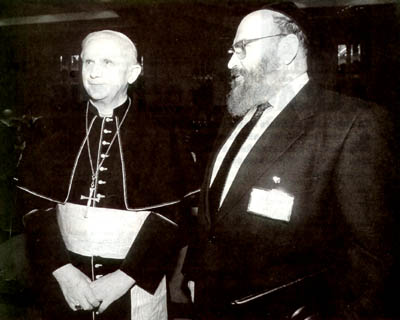 Cardinal Ratzinger in a friendly pose with rabbi Sirat at the International Jewish-Christian Conference at Jerusalem in 1994 30 Dias, February 1994 |
* In a letter of January 17, 1208 addressed to the Count of Nevers, France, (14) Innocent III (1198-1216) lamented that feudal lords were employing Jews as “ministers of their extortions” because they exploited Christians through the practice of usury. (15)
* In 1239, after receiving a report compiled by Nicolas Donin, a converted Jew from La Rochelle, that showed 35 articles in the Talmud insulting the Catholic Faith, Gregory IX (1227-1241) wrote to the Western Bishops and Sovereigns ordering all copies of the Jewish book to be confiscated. He appointed William of Auvergne, Bishop of Paris, to make an investigation on the matter. Once examined, the Talmud was condemned and copies of it were burnt publicly in Paris in 1242. At the request of the Jews, the book was examined again in 1248 and definitively condemned by William of Auvergne and the masters of theology from Paris, among them St. Albert the Great. (16) In the work Excerpta talmudica [Excerpts from the Talmud], written to justify the condemnation, one reads:
“By a secret design of Divine Providence, the errors, blasphemies, and outrages contained in the Talmud had hitherto escaped the attention of the Doctors of the Church. The wall has finally been removed, and now one can clearly see the reptiles, the abominable idols that the house of Israel adores.” (17)
* Innocent IV (1243-1254) ordered the Talmud to be burned because it was filled with errors and blasphemies. (18) In the Bull Sicut tua nobis of July 23, 1254, he authorized the Archbishop of Vienna to expel the Jews from his Diocese on account of their actions against the Catholic Faith and their disobedience of Church statutes. (19)
* In the Bull Damnabili perfídia of July 15, 1267, Clement IV (1265-1268) also condemned the Talmud. (20)
* In the Bull Nimis in partibus anglicanis of November 18, 1285, Honorius IV (1285-1287) took the same attitude as his predecessors regarding the Talmud. (21)
* John XXII (1316-1334) again condemned the errors of the Talmud in the Bull Dudum felicis recordationis of September 4, 1320. (22)
* In the Bull Dudum ad nostram of August 8, 1442, Eugene IV (1431-1447) prohibited the Jews not only from living with Christians, as the Third Lateran Council had already established (Decree V, VI, 5), but also from living among Christians, given the continuous blasphemies and attacks of the Jews against the Catholic Faith. (23)
* Nicholas V (1447-1455), Calixtus III (1455-1458), and Paul II (1464-1471) reenacted or renewed the decisions of their predecessors. (24)
* In the Bull Intenta semper salutis, of May 31, 1484, Sixtus IV (1471-1484) ordered that Jews and Muslins in Spanish lands should live separate from Christians, should wear different clothing, and should not have Christian maids or servants in their houses, in addition to other measures aimed at protecting the faithful from dangers to the Faith resulting from living with Jews. (25)
The Talmud is considered one of the most important books of the Jewish religion. It wields a great influence on Jews, surpassed only by that of the Torah, the work that contains the principal books of the Old Testament. The Talmud contains the doctrines, laws, and commentaries on Judaism made by the most expressive rabbis throughout History. The following are some of the statements contained in the Talmud: “1. The souls of Jews have the privilege of being part of God himself. The souls of the other peoples of the earth come from the devil and are similar to those of animals .... “5. As they await the coming of the Messiah, Jews live in a state of continuous war with the other peoples. When the victory is definitive, the peoples will accept the Jewish faith, but it is only the Christians who will not participate in this grace. On the contrary, they will be completely annihilated, because they descend from the devil .... “8. Only the Jews are men; the other peoples are no more than types of animals. The dog is worth more than the non-Jews. The non-Jews are not only dogs, but asses. The souls of the non-Jews come from the impure spirit and the souls of Israel come from the spirit of God. “9. The non-Jews were only created to serve the Jews day and night, without deviating from their service. “10. It is prohibited for the Jew to praise the learning or virtue of a Christian. “11. It is not just to use mercy toward enemies .... “14. The Jews can be hypocritical with the non-Jew .... “16. God granted all power over the goods and the blood of other peoples to the Jews. “17. A non-Jew who robs a Jew, even should it be an alms, should be killed. On the contrary, it is permitted for Jews to do evil to non-Jews. To despoil a pagan [that is, a non-Jew] is allowed .... “19. You can deceive an outsider and practice usury against him .... “21. Whoever loves a Christian would hate his own creator .... “23. Annihilate the best of the non-Jews. Take the life of the most honest of the idolaters. “24. If a pagan falls into a pit, we should cover the pit with a stone and try to prevent any measure that he might employ to get out. When we see him fall into a river or in danger of death, we should not save him. Maimonides counsels giving death wounds to every non-Jew when this lies within our powers. It is just to exterminate every heretic [that is, non-Jew] with your own hand; whoever sheds the blood of the impious offers a sacrifice to God .... “Those who deny the teaching of Israel, particularly the followers of the Nazarene, should be killed and it is always a good work to execute them; if this is not possible, we should try to cause their deaths. But whoever kills a soul of Israel will be judged as if he had killed the entire world ....” (apud H. Delassus, La conjuration antichrétienne, vol. 3, pp. 1125-1128) |
* Julius III (1550-1555) approved the confiscation and burning of talmudic books by the Inquisition. He also authorized the edict of the Inquisition of September 12, 1553 ordering Princes, Bishops, and Inquisitors to do the same. In the Bull Cum sicut nupe, of May 29, l554, the Pope ordered the Jews to hand over all their books containing blasphemies or insults against Our Lord Jesus Christ. (27)
* Paul IV (1555-1559) enacted severe measures to defend the integrity of the Faith and prevent the Jews from dominating Catholics. In the Bull Cum nimis absurdum of July 14, 1555, the Pope ordered the Israelites of Rome and other cities in the Pontifical States to live separate from Christians in their own neighborhood. He also established that there should be only one synagogue per city and that Jews could not have Catholic servants, work in public on Catholic feast days, write dishonest contracts, etc. (28)
The Jews attempted to bribe Paul IV by offering him 40,000 escudos to annul the Bull. (29) Along with other measures, the Pontiff ordered the destruction of the talmudic and anti-Catholic books of the Jews. (30)
* Pius IV (1560-1565) in 1564 placed the Talmud on the Index librorum prohibitorum [Index of forbidden books] and prohibited books interpreting, commenting or expounding on it. (31)
* In the Bull Hebraeorum gens of February 26, 1569, St. Pius V (1566-1572) expressly condemned the Jews who dedicated themselves to the practice of “divination, sortilege, sorcery and witchcraft.” (32) In that bull St. Pius V also accused the Jews of other crimes such as usury, theft, receiving stolen goods, and soliciting for prostitution. He closes his bull with these words:
“Finally, we consider as known and proven how offensively this perverse generation [the Jews] offends the name of Christ, how hostile it is to those who carry the name of Christians, even making attempts against their lives.” (33)By a decree of February 26, 1569, St. Pius V expelled the Jews from the Pontifical States, since, in addition to the mentioned crimes, the Jews spied for the Muslims and supported their plans of conquest that endangered all Christendom. (34) In this Brief, he said:
“We know that this most perverse people have always been the cause and seed-bag of almost all the heresies.” (35)To this vigilant energy against the Jewish perfidy, St. Pius V added his zealous desire for their conversion. One of the most remarkable conversions he achieved was that of the chief-rabbi of Rome, Elias, followed by the conversions of his three sons and one grandson. On June 4, 1566, they solemnly received Baptism at St. Peter’s Basilica in the presence of the Sacred College of Cardinals and a multitude of the faithful. (36)
* In the Brief of May 27, 1581, Gregory XIII (1572-1585) warned the faithful and religious authorities against the false conversions of Jews as a means to infiltrate the Catholic Church. (37) In the Bull Antiqua Judeorum improbitas of June 1, 1581, the Pontiff established these conditions for when Jews must be submitted to the vigilance of the Inquisition:
a. when they attack Catholic dogmas;In the Brief of February 28, 1581, the Pope reaffirmed the prohibition against Jewish physicians tending to Catholic patients. (39)
b. when they invoke devils or offer sacrifices to them;
c. when they teach Catholics to do the same;
d. when they speak blasphemies against Our Lord and Our Lady;
e. when they try to induce Catholics to abandon their Faith;
f. when they forbid a Jew or an infidel to convert;
g. when they consciously favor heretics;
h. when they disseminate heretical books;
i. when, in disdain for Our Lord, they crucify a lamb – principally on Good-Friday – and then spit on it and spew it with insults.
j. when they oblige Catholic wet-nurses to pour their milk into the toilettes and sewers after they have received the Eucharist. (38)
* In the Bull Cum Hebraeorum of February 28, 1593, (40) Clement VIII (1592-1605) proscribed talmudic and cabalistic books, as well as works written in Hebrew containing errors. (41) The prohibition contained in this bull was included as a norm in the Index, published on March 27, 1596.
In 1592 Clement VIII re-established the preaching of sermons aimed at the conversion of the Jews and, at the same time, in the Bull Caeca et obdurata of January 25, 1593, reiterated the decrees of Paul IV and St. Pius V expelling them from the States of the Church, with the exception of the cities of Rome, Ancona, and Avignon. (42)
* Urban VIII (1623-1644) sent a Brief to the King of Spain on January 15, 1628 opposing the crime of usury practiced by the Jews of Portugal. (43)
* On September 15, 1751, Benedict XIV (1740-1758) signed and promulgated a document reaffirming the cautionary measures regarding the Talmud taken by the Popes since Innocent IV. (44)
* In October 1775 (45) and January 1793 (46), Pius VI (1775-1799) published two edicts confirming the directives of Benedict XIV regarding the Jews.
* Through a letter by his Secretary of State, Cardinal Merry del Val, St. Pius X (1903-1914) warmly praised the classic work of Msgr. Henri Delassus, La conjuration antichrétinne [The anti-Christian Conspiracy], which exposes the conspiracy of Judaism and Freemasonry against the Catholic Church and Christian Civilization. (47)
There are still many other Bulls of Popes and Decrees of Roman Congregations regarding the Jews, published in various collections and monographs, which number in the hundreds. In Juifs et chrétiens (cols. 1735-1736), F. Vernet presents copious documentation on this topic, transcribed here for readers who may be interested in learning more on the matter. * Corpus juris canonici, Decretal. V. 6; Sextus Decretal., V, 13; Decret. Gratiani, Iª, XLV, 3, 5, LIV, 12-18; II, XIV, VI, 2, XXVIII, I, 10-15, 17; IIIq, IV, 93, 94, 98 and Septiumus Decretal., V, 1; A. Guerra, Pontificiarum constitutionum epitome, Venice, 1772, vol. I, pp. 191196 (summarizes 38 Bulls published in the Bullarium Romanum, Bullarium magnum, and other works); * L. Ferraris, Prompta bibliotheca canonica, Venice, 1782, vol. IV, pp. 208-37 (summarizes a large number of Constitutions by Popes and the Roman Congregations); * E. Rodocanachi, Le Saint Siège et les Juifs, Paris, 1891, pp. 322-29 (gives an overall picture of the main Bulls relating to the Jews); * F. Vernet, Le Pape Martin V et les Juifs, in Révue des Questions Historiques, Paris, 1892, vol. 51, pp. 410-423 (analyzes 84 documents), and Papes et Juifs au XIe. siècle, in L’Université Catholique, Lyon, 1896, vol. 21, pp. 73-86 (analyzes documents from the Formularium of Marin d’Eboli regarding the Jews); * M. Stern, Urkundliche Beitrãge über die Stellung der Pãpste zu den Juden, Kiel, 1893-1895, 2 volumes. The first volume contains the documents by Martin V and his successors; the second covers documents from Innocent III to Innocent IV; • K. Eubel, Zu dem Verhalten der Pãpste gegen die Juden, in Römische Quartalschrift, Rome, 1899, vol. 13, pp. 29-43 (about the Popes who preceded Martin V); * Constant, Les Juifs devant l’Eglise et l’Histoire, Paris, undated, 2nd ed., pp. 267-323, includes 16 Bulls on the topic; * Gregoire des Rives, Epitome canonum conciliorum, Lyon, 1663, pp. 264-68; * A. Geiger, Das Verhalten der Kirche gegen das Judenthum, in Das Judenthum und seine Geschichte, Breslau, 1870, vol. 2, F. Frank, Dir Kirche und die Juden, Regensburg, 1893. About the Church and the Jews in the Pontifical States, see: F. Gregorovius, Le ghetto et les Juifs de Rome, in Promenades en Italie, Paris, 1894, pp. 1-60; E. Natali, Il ghetto di Roma, Rome, 1887, vol. 1; E. Rodocanachi, Le Saint Siège et les Juifs - Le ghetto à Rome, Paris, 1891; A. Berliner, Geschichte der Juden in Rom, Frankfurt, 1893, 3 vols.; H. Vogelstaein - P. Rieger, Geschichte der Juden in Rom, Berlin, 1895-96, 2 vols. On the Church and the Jews of Avignon, see: L. Bardinet, Condition civile des Juifs du Comptat-Venaissin pendant le séjour des Papes à Avignon, in Révue Historique, Paris, 1880, vol. 12, pp. 1-47; R. de Maulde, Les Juifs dans les Etats français du Saint-Siège au Moyen Âge, Paris, 1886, as well as numerous articles in Révue des Études Juives. |
B. Councils “condemned” by John Paul II
The following councils were also included in the radical “anathema” that John Paul II issued at the Roman synagogue:
* The Council of Elvira (302), held at the end of Diocletian’s persecution against the Christians, issued a canon that forbade Christians from giving their daughters in marriage to Jews; another canon prohibited Christians from sitting at the table with Hebrews. (48)
* These prohibitions were confirmed and renewed by the Councils of Laodicea (4th century); Vannes (465); Agda (506); Epaona (517) and by the three Councils of Orleans (530, 533, and 541). (49)
In a canon repeated in the Decree of Gratian, (III, D.IV, 93), the above-mentioned Council of Agda set down a series of precautions to be taken before baptizing Jews, “whose perfidy often makes them return to their vomit.” (50)
* The Council of Mâcon (581) enjoined Jews from holding posts allowing them to impose penalties on Christians. (51)
* In canon 14, the Council of Toledo (589) barred Jews from taking Christian women as wives. (52)
* The Council of Paris (614) sustained the prohibition against giving Jews public posts, whether civil or military. (53)
* The Fourth Council of Toledo (633), canon 59, stated that the sons of Jews who had falsely converted and then returned to Judaism should be educated in Catholic monasteries; it also ratified the measures adopted by King Sisenando regarding the Jews. (54)
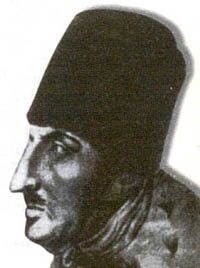 The Jews record a long string of false messiahs. It is another evidence of Our Lord Jesus Christ's unique mission. Above, Jacob Frank, a sham messiah. Below, Sabbatai Zevi, another one. 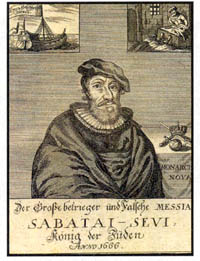 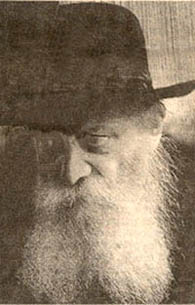 Above, Menachen Schneerson from Brooklin, NY, a contemporary "messiah" who died June 12, 1994 without fullfilling his supposed mission |
* The Seventeenth Council of Toledo (694) was held to analyze a plot aiming to install a kind of Judaism in Spain under the appearance of the Catholic Religion. (56)
* Other Councils also forbade Catholics from hiring Jewish physicians, servants, and nursemaids. According to some Catholic moralists of the 18th century, depending on the circumstances, to violate these prescriptions could constitute a mortal sin. (57)
* The Second Ecumenical Council of Nicea (787) denounced the false conversions of Jews. (58)
* The Council of Metz (888), reaffirming former proscriptions in canon 7, prohibited Christians from taking meals with Jews. (59)
* The Third Ecumenical Council of Lateran (1179) forbade wealthy Hebrews to take Christian nursemaids and slaves into their service. (60) It also anathematized those who, preferring Jews to Christians, received testimonies of Jews against Christians and not of Christians against Jews. (61)
* The Fourth Council of Avignon (1209) forbade Christians from dealing with Jews in financial matters; canons 3 and 4 impose the threat of excommunication for such dealings. (62)
* The Fourth Ecumenical Lateran Council (1215), canon 67, condemned usurious Jewish money-lenders and prohibited Christians from engaging in commerce with them. Canon 68 ordered Jews to wear clothing that would distinguish them from Catholics, and also forbade them from appearing in public on Good Friday to prevent them from mocking the Christians with their festive dress. Canon 69 reaffirmed the prohibition of the Council of Toledo regarding Jews holding public posts. Finally, canon 70 condemned the Jews who, albeit claiming to have converted to the Catholic Faith, continued to practice rites of the Hebrew religion. (63)
* The Council of Narbonne (1227) established that Jews should wear a distinguishing mark in the shape of a small circle. According to J. Levi in an article in the Révue des Études Juives, (64) the circle symbolized the Host, habitually profaned by Jews. This emblem was adopted to be worn by the Jews everywhere except Spain. The Popes proposed such a symbol in order to distinguish Jews from Christians, since,
“favored by confusion, the Jews have infiltrated Catholic ranks and committed crimes that would have been difficult or impossible to carry out if there had been a suspicion or it was clearly known that they were Jews.” (65)* The Ecumenical Council of Basel (1434), among other measures, required the Jews to listen to Christian preachers and prohibited Catholics from participating in Jewish feasts. (66)
C. Fathers, Doctors, Saints, and Catholic writers “condemned” by John Paul II
The following authors – a list including Doctors of the Church – criticized the Jewish onslaught against the Catholic Faith. They are also included in John Paul II’s “anathema”:
* From the Origin of Christianity to the Edict of Milan (313)
St. Justin, Dialogus cum Tryphone; Tertullian, Adversus Judaeos; St. Cyprian, Testimonia ad Quirinus; Pseudo-Cyprian, De montibus Sina et Sion and Adversus Judaeos; Novaciano, De cibis Judaicis; Celsus, Ad Vigilium Episcopum de Judaica incredulitate; De solemnitatibus sabbatis et neomeniis. Also St. Irenaeus, Origen, Commodian, Ariston de Pella; Mistiades, St. Serarius of Antioch, Theodotus of Ancyra, Zephirus, Artapanus [a converted Jew]. (67)
* From 313 to 1100
In the East: Eusebius; St. Gregory of Nissa, St. John Crysostom; St. Basil of Seleucia; St. Anastasius of Sinai; St. Ephrem, St. Isidore of Pelusa; Theodore Abucara; Eusebius of Emesa; St. Cyril of Alexandria; Theodoretus of Cyrus; Jerome of Jerusalem; Leontius of Naples in Cyprus; Stephan of Bostra.
In the West: St. Leo the Great; Evagrius, Altercatio Simionis Judaei et Theophili Christiani; St. Sidonius Apollinarius, De altercatione Ecclesiae et synagogae dialogus; St. Jerome; St. Ambrose; St. Augustine, De Fide Catholica ex Veteri et Novo Testamento contra Judaeos and Adversus quinque haereses; Severus of Minorca; St. Maximus of Turin; Cassiodore; St. Gregory the Great; St. Bruno of Würzburg; St. Isidore of Seville, De Fide Catholica contra Judaeos; St. Ildefonso of Toledo; St. Julian of Toledo; Paulo Alvares de Cordoba; St. Agobard of Lyon, De Judaicis superstitionibus, X; De insolentia Judaeorum, IV; Amolon of Lyon, Contra Judaeos; Rabano Mauro; Fulbert de Chartres; St. Peter Damian.
* From 1100 to 1500
Odon of Cambray; Gilbert Crispin; Guibert de Nogent; Rupert de Deutz; Peter the Venerable, Adversus Judaeorum inveteratam duritiam; Richard de Saint-Victor, De Emmanuele, Book II; Inguetto Contard; Gautier de Chatillon and Baudoin de Valenciennes; Alain de Lille, De Fide Catholica; William of Auvergne; St. Albert the Great; St. Thomas Aquinas, De regimine Judaeorum ad ducissam Brabantiae; Summa Theologiae, III, q.47, a.5-6; Raymond Martin, Pugio Fidei adversus Mauros et Judaeos; Victor Porchetto de Selvatici; Nicolas de Lire; Lauterio de Batineis; Bernard Oliver; Jean de Baconthorpe; Paul of Venice; Stephan Bodiker, Bishop of Brandenburg; Juan de Torquemada; Peter George Schwartz; St. Antonin of Florence, Dialogus discipulorum Emauntinorum cum Peregrino; Paulo Morosini, De aeterna temporalique Christi generatione; Pedro de Brutis, Victoriae adversus Judaeos; etc.
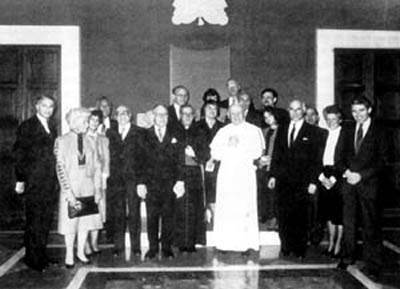 On March 22, 1984, a smiling John Paul II received representatives of the Jewish organization B'nai B'rith of New York. "It is a meeting of brothers," he told them. |
* From 1500 to our days
I cite below only a few of the most consequential works from the vast number of writings attesting to the Jewish perfidy against the Church:
J. L. Vives, De veritate Fidei Christianae; P. Du Plessis-Mornay, Traité de la verité de la Religion Chrétienne; P. Charron, Les trois vérités contre tous les athées, idolâtres, Juifs...; H. Grotius, De veritate Religione Christianae; Bossuet, Discours sur l’Histoire Universelle; J. Bartolocci, Bibliotheca magna rabbinica; P. L. B. Drach, Lettres d’un rabin converti aux Israélites ses frères; J. M. Bauer, Le Judaïsme comme preuve du Christianisme; P. Loewengard, La splendeur Catholique – du Judaïsme à l’Eglise. (68)
D. The previous Canon Law was also “condemned” by John Paul II
The prescriptions set out in past Canon Law about the Jews, which John Paul II would have also included in his "anathema," can be summarized as follow:
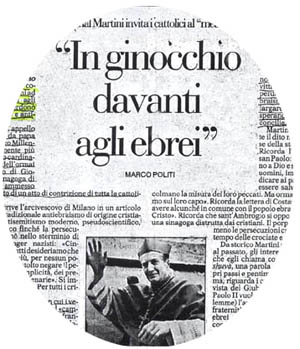 "Fall to your knees before the Jews" This is the imperative order Cardinal Carlo Martini of Milan issued to Catholics. An attitude diametrically opposed to the 2,000-year-old teaching of the Catholic Church - La Repubblica, September 24, 1997 |
1. Jews may neither have Catholic slaves nor employ Catholic maids for their houses or families. Catholics are forbidden to accept permanent paid employment in Jewish homes;E. Conclusion
2. Catholic women are particularly forbidden from accepting employment as breast-feeding nursemaids in Jewish homes;
3. In case of illness, Catholics are forbidden to go to Jewish doctors and use medicines prepared by Jewish hands;
4. Catholics are forbidden, under pain of excommunication, to live with Jews.
5. Jews should be barred from holding public posts that would give them authority over Catholics;
6. Catholics are forbidden to attend Jewish weddings and take part in their feasts;
7. Catholics may not invite Jews for meals nor accept invitations from them. (69)
These countless Popes, Councils, Fathers, Doctors, and Saints of the Catholic Church, as well as the ensemble of her past Canon Law dealing with the Jews, were all supposed to be 'excommunicated' by John Paul II when he affirmed that “whomsoever” had combated the Jews “at all times” would be at fault.
As he cast his anathema in his Allocution, John Paul II invoked a very recent “tradition,” as he himself noted, that of Vatican Council II with its Declaration Nostra aetate, and the example of John XXIII. Regarding the latter, John Paul II asserted:
“The inheritance that I now want to have recourse to is precisely that of Pope John, who passing by here [the synagogue] one time .... stopped his car in order to bless the throng of Jews who were leaving this very Temple.” (70)Now then, the 22-year-old “tradition” of the Council and the single example of Pope John XXIII hardly carries the weight to bring into question the 2,000-year-old tradition of Catholic teaching. Rather, its deliberate opposition to the Magisterium of the Church would seem to define a rupture in that teaching.
In this case, John Paul II clearly appeared to break with a tradition of the Ordinary Pontifical Magisterium. Facing this patent contradiction, a faithful Catholic is obliged to ask: Who is right? Is it the Church, which for serious reasons of a theological nature was vigilant for 2,000 years against the enmity of the synagogue? Or is it John Paul II who, ignoring that wise rationale, went to the synagogue and, without even alluding to the ancient errors of the Jews, began to defend them and condemn the prior conduct and constant teaching of the Church on the matter?
3. Analysis of John Paul II’s allocution to the Jews
To analyze the profound meaning of the Pontiff’s visit to the synagogue, one must look closely at the Allocution he delivered there.
Here is the nucleus of the papal speech:
“Today’s visit is intended to make a decisive contribution to the restructuring of good relations between our two communities, following the examples given by so many men and women from both parties who were and still are earnestly committed to overcome the old prejudices and allow for the ever fuller recognition of that ‘bond’ and ‘common spiritual heritage’ existing between Jews and Christians.Let me analyze the main statements of John Paul II, emphasized above in bold.
“This is the wish already expressed in the fourth paragraph of the conciliar Declaration Nostra aetate, (71) which I just referred to, about relations between the Church and non-Christian religions. The decisive turnaround in relations between the Catholic Church and Judaism, and with Jews individually, took place with this brief but incisive paragraph.
“We all are aware that three points stand out especially among the many riches of this n. 4 of Nostra aetate. I would like to emphasize them here before you, in these truly unique circumstances.
“The first is that the Church of Christ discovers her ‘link’ with Judaism by ‘sounding the depths of her own mystery.’ (72) The Hebrew religion is not ‘extrinsic’ to us, but is somehow ‘intrinsic’ to our religion. We have, therefore, relations with it that we do not have with any other religion. You are our beloved brothers and in a certain way one could say, our older brothers.
“The second point stressed by the Council is that no atavistic or collective guilt can be attributed to the Jews as a people for ‘that which was done in the Passion of Jesus’ (73) – to neither the Jews of that time, nor those who came later, nor those of today. Therefore, the pretended theological justification of discriminatory or persecutory measures is inconsistent. The Lord will judge each one - whether he be Jews or Christians - ‘according to his own works’ (Rom. 2:6).
“The third point in the conciliar Declaration that I want to underscore is a consequence of the second: it is not licit to say .... that the Jews are ‘reprobates or accursed,’ as though this were taught by or could be deduced from Sacred Scriptures (74) and the Old or New Testaments. This was already stated in the same passage of Nostra aetate and also in the Dogmatic Constitution Lumen gentium (n. 6)....
“Upon these convictions we support our present relations. On the occasion of this visit to your synagogue, I want to reaffirm and proclaim their perennial value. This is, therefore, the meaning that should be attributed to my visit to you, Jews of Rome.” (74)
A. “Decisive contribution” to “overcome the old prejudices”
What did John Paul II mean by “old prejudices” when he said that he was following the example of those who were committed to overcome the old prejudices? To better understand the underlying thinking of the Pontiff, I will begin by looking at the various possible meanings of this expression.
a. Racial prejudice?
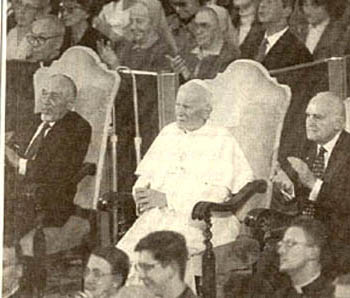 On April 7, 1994, John Paul II promoted an outdoor concert of Jewish singers at St. Peter's Square. The pretext was to remember the victims of the Nazi persecution. On one side of the Pope was chief-rabbi Toaff in a place of honor symetrical to Italian president Scalfaro. - Corriere della Sera, April 8, 1994 |
“This ‘long period’ of Christian anti-Semitism – which was based primarily on religious motives and should not be confounded with modern anti-Semitism which, having culminated in the ‘holocaust,’(75) was caused by economic, nationalist, and racist motives rather than religious ones, even if it may have taken advantage of the latter – ended with the pontificate of John XXIII and Vatican Council II.” (76)b. Temperamental or emotional prejudices?
Having discarded out of hand the hypothesis that the “old prejudices” had a racial character, one could ask whether John Paul II was referring to some temperamental or emotional prejudice in the Catholic Church against the Jews, unconnected to matters of Faith?
History has objectively recorded the facts that took place in the relations between the Catholic Church and the Synagogue. And even though such facts may displease the progressivist current, this does not change their essence. “Historia vero testis temporum, lux veritatis, vita memoriae, magistra vitae, nuntia vetustatis.” [History is the witness of all times, the light of truth, the life of memory, the mistress of life, the messenger of antiquity.] (77)
Analyzing the facts of History, one finds more “old prejudices” of Jews against Catholics rather than the contrary. The constant hatred of Jews for Catholics generated direct and indirect persecutions of Jews against Catholics. Let me set out some facts recorded by History of persecutions of both types.
* Direct persecutions of the Jews against Catholics
* The Jews never ceased to plot against the Catholic Faith since the crime of Deicide. It was they who instigated the first persecution against the Church in Jerusalem by arresting St. Peter (Acts 12:3), stoning to death St. Stephen (Acts 7:54-58), and beheading St. James the Greater (Acts 12:1-2). They ordered the Apostles to be whipped (Acts 5:40) and stirred up Saul against the disciples (Acts 8:3). After the conversion of St. Paul, they persecuted him with calumnies and instigated revolts against him (Acts 13:50; 17:5). In the year 65 in Jerusalem, they dragged him out of the city in order to kill him. The Apostle of the Gentiles was saved by the pagan tribune Lysias, who, to rescue him from the hands of the infuriated Jews at Jerusalem, ordered him flogged and sent him under a guard to Caesarea (Acts 24:7).
* St. Paul himself bears witness to this radical hatred directed against him when he wrote that the Jews “never ceased to combat the Church of Jesus Christ” (I Thes. 2:14).
* As soon as the nascent Church had begun to rise up in Rome, the local Jews tried to drown her in the blood of the first Christians. Rome was burned in the year 64 AD. The mystery over whether it was Jews or pagans who ordered the burning of Rome during the reign of Nero is debated even to this day. But those who profited were mainly the Jews who held sway over the Emperor. (78) The fire served as a pretext to set off the bloody persecutions of the pagan Emperors against the first Christians. (79)
* Since the year 70 AD, with the fall of Jerusalem to the troops of Vespasian and Titus, the writings of the rabbis became more and more violent and hostile toward Christians. (80)
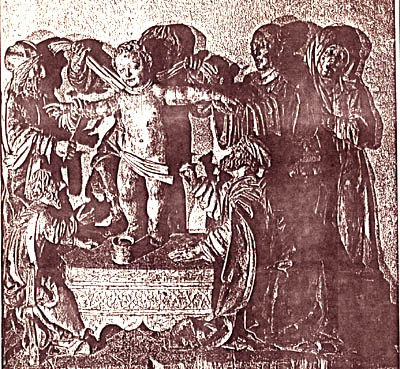 A woodcraft from the Diocesan Museum of Trent representing a group of Jews inflicting tortures on St. Simonino Unverdorben, or St. Simon of Trent. According to reliable historic documents, Simonino, a child of 30 months, was kidnapped and murdered in Trent by seven Jews in a religious ritual during their Pesah in 1475. The mutilated body of the child was found in a sewer, and transported to the Church of St. Peter where it still remains. Similar ritual killings of children by Jews occured in Cologne, Moguncia, Trever, Lublin, and Lincoln. In 1584 St. Simonino was introduced into the Roman martyrology. In 1588 Pope Sixtus V allowed a special Divine Office and Mass in honor of St. Simonino. In 1965 Paul VI removed St. Simonino from the list of Saints. Notwithstanding, the cult of the little saint continues to be very popular in Trent. - Historia, October 1991 |
* In the era of the Church of the Martyrs, the Jews were almost always among those who incited massacres of Christians. According to the Letter of the Church of Smyrna (chapters 12 and 13), a chronicle of the martyrdom of St. Polycarp written by the faithful, the Jews played an important role in bringing about the execution of St. Polycarp, (83) carried out on February 23, 155, the day of the great Sabbath. When the Bishop-martyr was condemned to be burned, the unruly rabble hastened to gather the wood for the fire, and “as was their custom, the Jews were the ones who showed the greatest eagerness in this task.” (84)
* During the persecution by Decius in 250, also in Smyrna, St. Pionius and his companions Sabina and Asclepiades were sent before the judge on the anniversary of the martyrdom of St. Polycarp. A large number of Jews came to demand the death of the Christians who refused to apostatize. “These people have already lived too long!” they shouted. (85)
* St. Calixtus, Pope from 217 to 222, was another illustrious victim of Jewish hatred in the early years of the Church. A former slave, St. Calixtus had made some unsuccessful business deals on behalf of his master and sought the help of his creditors, among them, some Jews. The latter denounced him as a Christian to the pagan authority. The prefect had him scourged and condemned him to forced labor in the mines of Sardinia. (86)
* In his work Contra Celsum (VI, XXVII), Origen confidently stated that the Jews gave rise to the calumnies that were so ominously fateful to Christians. According to him, the Jews were the ones who spread the rumor that Christians ate beheaded children in their nightly meetings in the Catacombs. (87)
* Julian the Apostate found his best allies in the Jews during his war against Our Lord Jesus Christ. St. Gregory Nazianzen said that the Jews’ centuries-old hatred for Christians was what motivated them to assist the tyrant. (88)
* Eusebius related how Emperor Constantine the Great, in a letter about the celebration of Easter, recalled the implacable persecutions of the Jews against Christians. He advised: “Let there be nothing in common between us and the most inimical rabble of the Jews.” (89)
* Jewish hatred for Christians was also present in the East. King Sapor’s persecution of Christians in Persia in the mid-fourth century was instigated by the Jews, “these perpetual enemies of Christians who are always found in turbulent times, constant in their implacable hatred and unhesitating in making any calumnious accusation,” according to the Acts of St. Simeon-bar-Sabae, Patriarch of Seleutia, who died in 341. (90)
* At the beginning of the 5th century, the Jews in Alexandria fueled an eruption of violence against the Christians. (91)
 A clipping from a Brazilian newspaper reported that the first issue (July 1997) of the Jewish bi-monthly Galileo magazine, published in Jerusalem, printed a picture of the Virgin Mary with a head of cow superimposed over hers. When the editor, Stephen Svtiski, was asked for an explanation, he sarcastically replied that was just a study of a cloning technique between humans and animals. Fr. Elias Audi, in Nazareth, commented that "the episode reflects the mentality of the Jews that they are the elect people and others do not deserve any respect." - Estado de Sao Paulo, July 5, 1997 |
* In the year 608, the Jews in Antioch – taking advantage of the invasion of Syria by the troops of Bonosius – attacked the Christians, killed a large number of them and burned their corpses. According to Graetz, they tortured the Patriarch, St. Anastasius with sophisticated cruelty, dragging him through the streets of the city before murdering him. (93)
* Around the middle of the 7th century, the Jews persuaded the caliph Omar, who ruled Jerusalem, to tear down all the crosses in the city, especially the one on the Mount of Olives. (94)
* On the Iberian Peninsula, the Jews collaborated with the Muslims in the conquest of Visigothic Spain. (95)
* In 723 in Syria, an edict of Caliph Yezid ordered the destruction of all images “be they in temples, churches or homes.” From a report by Monk John to the Second Council of Nicea, Patriarch Nicephorus stated that it was a Jew from Tiberiad who suggested that Yezid take that measure, promising him a long reign if he did so. Notwithstanding that “prophecy,” Caliph Yezid died one year after issuing this edict. (96)
* Early in the 11th century, the Jews of Orleans, France, sent a letter to Sultan Hakem, then in possession of the Holy Places, “informing” him that Christian armies would soon be sent to re-conquer Jerusalem. This false story caused the Sultan to destroy the Church of the Holy Sepulcher and break the accord allowing Catholic pilgrims to visit the Holy Land. (97)
News of this insidious Jewish intrigue and the consequent profanations in the Holy Land by the Moors understandably gave rise to a surge of religious indignation throughout Europe. Were there exaggerations in that reaction against Moors and Jews? Probably. But the first ones to blame for possible excesses were the authors of that crime of profanation – the Muslims – and their Jewish “informers,” rather than to point the finger only at those seeking to redress the rights of their insulted Faith. To attribute such a religious reaction to a temperamental or emotional phobia would be a gross simplification.
Here I will close this sampling of Jewish hatred against the Holy Church expressed through direct persecutions in the first eleven centuries of the History of the Church.
History has also recorded indirect persecutions instigated by Jews against Catholics. Some of the more noteworthy of these will be presented next.
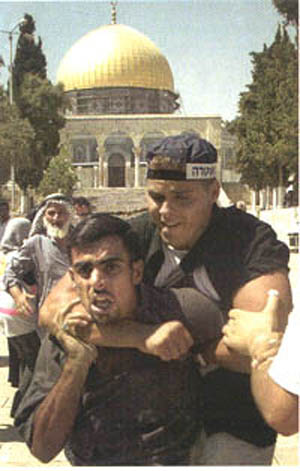 Inside the Vatican, October 2001 |
* Indirect persecutions waged by Jews against Catholics or Doctrinal hostilities
In addition to combating the Holy Church directly, the Jews have infiltrated Catholic circles to distort faith in Jesus Christ and the Most Holy Trinity, and thereby promote heresy. This is attested in the luminous text of Bossuet, in his comments on the Apocalypse.
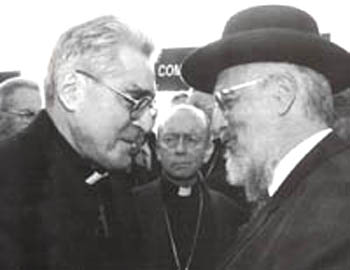 Cardinal Lustiger tête-à-tête with the chief rabbi of France. He told the Jewish Telegraphic Agency: "The decision to become Christian did not present itself to me as a negation of my Jewish identity." Inside the Vatican, December 1997 |
“Another sect, which originated from this one, so strongly diminished Jesus Christ as to place Him below Melchizedek. (99) It repeated the Jewish theories that reduced the Trinity to mere names. The same was affirmed at this time by Praxeas, whom Tertullian wrote against. Noetus also followed this error, which was later taken up by Sabellius, who made many disciples not only in Mesopotamia but also in Rome ....
“One sees clearly that these heresies were a remnant of this Jewish leaven .... and that the Christians who adopted them were, under the Christian name, Pharisees and Jews, as St. Epiphanius and other Fathers called them. (100)
“But it was never so obvious that these opinions came from the Jews as at the time of Paul of Samosata, Bishop of Antioch. When Arthemon took up the heresy of Cerinth and Theodatus, which reduced Jesus Christ to a mere man, Paul adhered to it along with Zenobia, the Queen of Palmyra, who was linked to the Jewish religion. (101) The Jews, therefore, were in fact authors of that impiety, and they incite this Queen to adopt it ....
“The consequences of this error for the Church were terrible, for it was accepted not only by Photinus, Bishop of Sirmium, but also by the Arians, the Nestorians, and all the other sects that later attacked the Divinity or the Incarnation of the Son of God, all of them being nothing more than offshoots of this Jewish heresy.
“The Church suffered for a long time, therefore, a kind of persecution by the Jews through the spreading of these pharisaic doctrines.” (102)
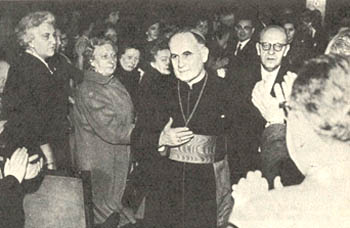 In 1967, Chilean Cardinal Silva Henriquez visited a synagogue in Santiago ICI, October 15, 1967 |
Here is what Bernard Lazare stated regarding the Jewish revolutionary role in History:
“From the 10th to 15th century, these ‘Jewish’ rationalists and philosophers were collaborators to which can be called the general Revolution of humanity....Lazare went on to point out the role played by Jews in Protestantism:
“The majority of Averroists were unbelievers, who more or less assailed the Christian religion. They were the direct ancestors of the men of the Renaissance. It is owing to them that the spirit of doubt .... worked itself out. The Florentine Platonists, the Italian Aristotelians, the German Humanists came from them. Thanks to them, Pomponazzo composed the treatises against the immortality of the soul; thanks to them, too, Theism, which corresponded to the decadence of Catholicism, sprang up among the thinkers of the 16th century.” (105)
“The Reformation in Germany as well as in England was one of those movements when Christianity acquired new force in Jewish sources. The Jewish spirit triumphed with Protestantism.Jewish influence was also felt in the French Revolution. Bernard Lazare pointed this out, providing the names of the chief collaborators and their functions:
“Against Catholicism the Jews equipped them with the formidable exegesis which the rabbis had cultivated and built up during centuries: the free-examination that Protestantism would make good use of.” (106)
“The Jews were implicated in all revolutionary movements, for they took an active part in all revolutions, as we shall see when we study their role during all periods of trouble and change. ...
“The Jewish spirit is essentially a revolutionary spirit, and consciously or otherwise, the Jew is a revolutionary. ...
“During the Revolution the Jews did not remain inactive, considering how few their numbers were in Paris. The position they occupied as district electors, officers of legion, and associate judges, was important.” (107)
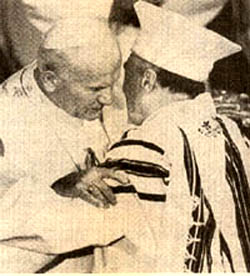 JPII and Toaff embraced three times during the visit to the synagogue Avvenire, January 9, 1993 |
“To no avail does the triple-crown [the papacy] fight against the scepter of the Jewish Revolution of 1793; in vain would it [the triple-crown] seek to free itself from the iron grip of the Semitic giant that clutches it; all of its efforts are useless. The danger is imminent, and Catholicism is dying to the degree that Judaism penetrates the layers of society.” (108)To the same effect, the English review The Mouth, in its October 1896 issue, substantiated the words of the Haschophet column:
“The Jews do not even try to disguise the fact that they, in their eternal hatred of Christianity, aided by the chiefs of Freemasonry, were the authors of the [French] Revolution.” (109)Bernard Lazare also said that Jews worked ardently in the communist and socialist revolutionary upheavals of the 19th century:
“During the second revolutionary period, which began in 1830, they displayed even greater ardour than during the first .... In labouring for the triumph of Liberalism, they were looking out for their own good. It is beyond a doubt that the Jews, through their wealth, energy and talents, supported and furthered the progress of the European revolution. In the second revolutionary period that starts in 1830, they showed even more ardor than in the first .... It is beyond doubt that with their gold, energy and capabilities, they sustained and helped the European revolution .... Their contribution to present-day Socialism was, as is well known, and still is very great .” (110)Another fact should be added to the documents attesting to the persecutions stimulated by Jews against Catholics, and that is their doctrinal hostility and participation in the revolutionary process that has been destroying Christendom. The precepts of the Talmud, which manifest a great hatred of the Church and Catholics, seek to give religious foundation to the Israelite loathing for Christianity. (111) This hatred was reinforced after the Talmud first came into force, that is, the 2nd century, when its foundations were laid by Barchochbas, Akiba and Aquila, until today. Bernard Lazare noted:
“The tanaim [early ‘teachers’] wanted to preserve the faithful from Christian contamination; for this purpose the Gospels were likened to books on witchcraft, and Samuel Junior, by order of the patriarch Gamaliel, inserted in the daily prayers a curse against the Christians, Birkat Haminim, which has furnished the foundation for the charge that the Jews curse Jesus thrice a day.” (111)Even if other documents were lacking, the Talmud canons highlighted in the box - above right - would constitute proof of the permanent hatred of the Jews for the Catholic Religion. (112)
Considering what has been expounded thus far, I find that the hatred of the Jews against Catholics throughout History is so visceral and unrelenting that one could say it fulfills the revelation God made to Isaiah, saying:
“For all that this people speaketh, is a conspiracy” (Is. 8:12).One could also say that this other warning of Isaiah applies to the historic role of the Jews against the Catholic Church in History:
“They have conceived labor (that is, hurting their neighbor) and brought forth iniquity.
“They have broken the eggs of asps, and have woven the webs of spiders: he that shall eat of their eggs, shall die; and that which is brought out, shall be hatched into a basilisk ....
“The work of iniquity is in their hands. Their feet run to evil, and make haste to shed innocent blood” (Is. 59:4-7).
Clearly, if there has ever been an emotional "old prejudice" in Church-Synagogue relations, it was not on the part of the Catholics, who suffered the effects of the Jewish conspiracy. Rather, it was held by the Jews, who took the initiative in the religious struggle.
Incidentally, shortly before the theories on National-Socialism came to light with their pagan and absurd ethnic pretensions, the conniving character of Judaism against the Church and its anti-Catholic hatred was widely evident and generally acknowledged among Catholics. From a certain point of view, the Nazi and Fascist persecutions against the Jews became very good tools to save Judaism from those well-merited accusations.
* The constant goodness of the Church toward persecuted Jews
In face of this bad treatment, the Church never ceased to charitably invite the Jews to convert and to receive them with open arms when they so deserved it. The Holy Catholic Church went even further than this. She always emphatically forbade the persecutions that were often waged by the people as a reaction to the constant hatred of the synagogue against the Church.
An official testimony of this stance can be found in a speech delivered at the Great Sanhedrin meeting in Paris on October 30, 1806 at the time of Napoleon. At that session, the Jews of France and Italy applauded the address delivered by rabbi Isaac Samuel Avigdor in which he recognized, and invited the Sanhedrin to acknowledge, the constant and unceasing benignity of the Catholic Church toward Jews. He began by calling to mind that the most celebrated Catholic moralists prohibited persecutions, professed tolerance, and preached fraternal charity. Here are some relevant excerpts from that text:
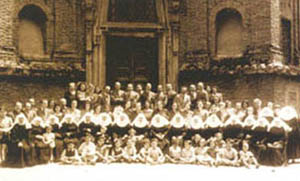 Above, Catholic nuns pose with the Jewish children they saved during World War II. Below, Hebrews whom Pius XII hosted in his Castel Gandolfo residence to escape the Nazi persecutions. 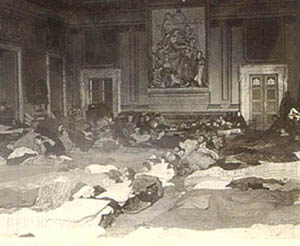 - Top photo, Inside the Vatican, February 2005; - Top photo, Inside the Vatican, February 2005;bottom, 30 Giorni, October 2001 |
“'Nothing is more opposed to Religion,' states St. Justin Martyr, 'than coercion in matters of Faith' (Book V).
“'Shall we persecute,' asks St. Augustine, 'those whom God tolerates?'
“In this regard, Lactance says: ‘Force-fed religion is not Religion. It is necessary to persuade rather than to force. Religion cannot be imposed’ (Book V).
“St. Bernard says: ‘Counsel, and force ye not.’ ....
“These sublime virtues of humanity and justice were often practiced by truly well-instructed Christians and, above all, by the worthy ministers of this pure morality that calms passions and instills virtues.
“As a consequence of these sacred principles of morality, at different times the Pontiffs protected and welcomed in their States the persecuted Jews expelled from several parts of Europe, and churchmen from all countries often defended them in many States in that part of the world.
“Around the middle of the 7th century, St. Gregory defended and protected the Jews throughout the whole Christian world.
“In the 10th century, the Bishops of Spain most energetically opposed the people who wanted to massacre them. Pontiff Alexander II wrote those Bishops a letter of congratulations for the prudent conduct they showed in this regard.
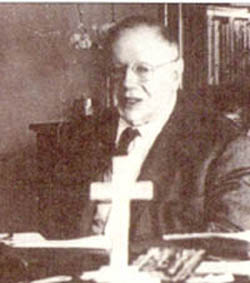 Rabbi Israel Zolli converted to Catholicism in 1945. He changed his name to Eugenio in honor of Pope Pius XII, Eugenio Pacelli Inside of the Vatican, February 1999 |
` “In the 12th century, St. Bernard defended them from the furor of the Crusaders.
“Innocence II and Alexander III likewise protected them.
“In the 13th century, Gregory IX protected them in England, France, and Spain from great calamities that threatened them; he forbade, under pain of excommunication, to coerce their consciences ....
“Clement VI granted them asylum in Avignon ....
“In the middle of the same century, the Bishop of Spira [Speyer] prohibited people who owed money to Jews from reneging on their obligation by asserting the oft-used excuse of usury.
“The following century, Nicholas II wrote the Inquisition to proscribe coercing Jews to embrace Christianity. ....
“It would be easy to cite an unlimited number of other charitable actions toward the Israelites, in numerous epochs, practiced by churchmen well-instructed in the duties of man and their Religion. ....
Someone could object that the Inquisition persecuted the Jews, and that ipso facto the Church is responsible for such treatment. I answer, saying: 1. The Tribunal of the Holy Inquisition, established to defend the integrity of the Catholic Faith, was not concerned about the Jewish religion as such, nor did it prevent the Jews from professing their false beliefs, so long as they did not propagate their convictions among Catholics. The Tribunal dealt only with those who hypocritically converted to Catholicism and entered the fold of the Church or those who, having sincerely converted, later relapsed into their old errors (Joseph de Maistre, Cartas sobre a Inquisição Espanhola, Niteroi: Leituras Católicas, 1949, p. 27). In the 16th century, the Jews were abusing the freedom that the Kings of the Iberian Peninsula gave them by means of constant blasphemies and attacks against the Catholic Faith. During this period, there were also large numbers who made false conversions to Catholicism. For these two reasons, the Jews came to pose a serious danger for the Faith in the Kingdoms of Portugal and Spain (Ernest Lavisse - Alfred Rambaud, Histoire Générale du IVe siécle à nos jours, Paris: Armand Colin, 1984, vol. 4, p. 332). Moreover, they endangered the political stability of those States (Juan Baptista Weiss, História Universal, vol. 8, p. 304). Then, in legitimate defense of the Faith and exercise of their position of temporal rulers, the Catholic Monarchs decreed that the Jews should choose either to leave the Iberian territories at the expense of the royal powers, or to remain as upright Catholics or as Jews without disseminating their false convictions. In the latter case, the Jews - and especially the converts - would be subject to the vigilance of the Inquisition insofar as matters of Faith were concerned. These were the measures the Spanish Inquisition took. It is necessary to emphasize, however, that such measures were adopted by the temporal powers of Spain and Portugal and not by the Church, and, therefore, they should not be attributed to her. 2. The tribunals of the Inquisition were mixed tribunals, composed partly of churchmen and partly of representatives of the temporal power. The churchmen judged crimes against the Faith and their sentences were restricted to the spiritual sphere. The representatives of the temporal power, in turn, executed the sentences which, in each State and in diverse and independent ways, corresponded to those spiritual sentences. A zealous defender of the autonomy between the spiritual and temporal powers with their different roles, the Church did not take part in the execution of civil sentences, with the obvious exception of providing spiritual comfort to those who were condemned (J. de Maistre, Cartas sobre a Inquisição Espanhola, pp. 17-18.; E. Vacandard, entry Inquisition, Dictionnaire de Théologie Catholique, vol. 7-2, col. 2065; Henri Hello, A verdade sobre a Inquisição, Petropolis: Vozes, 1936, p. 11; W. Devivier, Curso de Apologética Christã, São Paulo: Melhoramentos, 1924, pp. 457-9). Therefore, the Church cannot be accused of direct responsibility for the promulgation and execution of civil sentences issued by Inquisition tribunals in the several countries where it existed. Nor can she be held accountable for possible injustices committed by the temporal heads of the Inquisition. 3. The Roman Inquisition was a characteristic example of the Holy Church’s justice and equanimity in her judgments on matters of Faith. It was the only Church tribunal that had both temporal and spiritual functions. Since its establishment by Pope Paul III in 1542, it has always depended on the Sovereign Pontiffs. The Roman Inquisition was a celebrated model of an elevated juridical system and was recognized everywhere for its prudence and serenity in the distribution of temporal justice. It introduced various improvements in legal provisions favoring the defendant, placing it in the forefront of the most renowned legislations of the time, a fact acknowledged by impartial commentators even today (John Tedeschi, “A outra face da Inquisição,” O Estado de São Paulo, March 16, 1986, Cultural Supplement, pp. 1-4). The goodness of Roman Inquisition under the papal aegis became proverbial. This is indirectly recognized by a testimony of the Great Jewish Sanhedrin, transcribed below. For this reason, one can repeat, without exaggeration, the words of Joseph de Maistre that Rome was the “paradise of the Jews” (Cartas sobre a Inquisição Espanhola, p. 13). Also applicable is the popular German adage about those who lived under the temporal power of the Princes of the Church: How good it is to live under the shadow of the crosier! (R. Aubenas, Hérétiques et sorciers, Fliche-Martin, Histoire de l’Eglise, vol. 15, pp. 385-6.). Thus, no injustices or persecutions of the Jews can be attributed to the Church when she exercised her temporal duties. Therefore, the objection is erroneous in its foundation – the Inquisition persecuted the Jews – and in its consequence – that the Church also did the same. |
“For eighteen centuries, this circumstance in which we now find ourselves is the only one that has arisen for us to display the sentiments imbued in our hearts.
“This great and fortunate circumstance, which we owe to our august and immortal Emperor, presents us with the most opportune, excellent and glorious opportunity to express .... especially to the churchmen, our full gratitude toward them and their predecessors.
“Let us, therefore, gentlemen, hasten to take advantage of this memorable occasion to pay the just tribute of recognition that we owe them; let this room resound with the expression of our gratitude; let us solemnly bear witness to our sincere recognition for the uninterrupted benefits that they have let fall upon the generations that preceded us.” (113)
The Jewish assembly applauded this speech, voted to accept it, and inserted it in the proceedings of February 5, 1807. It later approved the following amendment: “The representatives of the Hebrew Synod in the Empire of France and the Kingdom of Italy .... are filled with gratitude for the successive benefits received from the Christian clergy for the Israelites in the various States of Europe in the past centuries;
“Fully acknowledge the welcome that several Pontiffs and many other ecclesiastics gave at different times to the Israelites from diverse countries ....
“Do here decree that the expression of these sentiments be recorded in today’s proceedings as a permanent and authentic testimony of the gratitude of the Israelites of this assembly for the benefits received by the generations that preceded them from churchmen of the various countries of Europe.” (114)
This unique manifestation of gratitude on the part of the Great Sanhedrin assembled in France stands as testimony to the benefits bestowed by the Church through the ages. It, along with the material presented above on the persecutions instigated by the Jews against the Catholic Religion, clearly show that that the Holy Church never had a temperamental or emotional bias that could serve as foundation for the statement by John Paul II that her history includes “old prejudices" against the Jews.
c. Theological prejudices?
In the absence, therefore, of an adequate historical foundation to uphold that the expression “old prejudices," employed by John Paul II, refers to racial or emotional prejudices against the Jews, one must ask whether the Pontiff was referring to doctrinal matters.
Was John Paul II referring to theological “prejudices”? To accept such a hypothesis, however, it would have to be asked if the very serious theological questions that separate the Catholic Church from the Synagogue are “prejudices”? For example, would it be a “prejudice” to affirm the Divinity of Our Lord Jesus Christ or to profess the dogma of the Most Holy Trinity? Or to proclaim the articles of Faith that derive from that?
These are questions that John Paul II did not answer. Instead he left the Catholics who followed the news of his visit to the synagogue of Rome in a state of perplexity, bewildered by the impression of a Pope who appeared to abandon the mentioned dogmas of our Faith in order to favor the Jewish religion.
B. “A decisive turnaround in the relations of the Catholic Church
with Judaism”
Svolta decisiva was the Italian expression chosen by the Pontiff to describe the new relations of the Catholic Church with Judaism. Svolta means a complete change of direction on a road. (115) A svolta decisiva is, therefore, a decisive turnaround.
According to John Paul II, the Declaration Nostra aetate triggered a crucial turnaround in Church relations with Judaism. A turnaround to which, as seen, he wanted to offer a “decisive contribution.” He could hardly have been more categorical in expressing a desire to abandon the previous doctrinal position of the Holy Church regarding Judaism.
C. “The Church of Christ discovers her link with Judaism
sounding the depths of her own mystery”
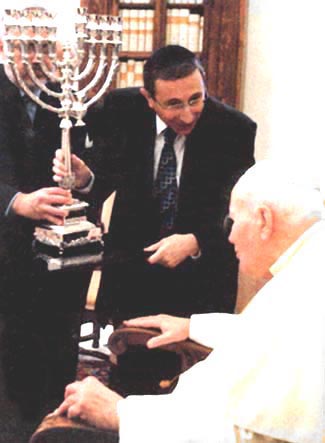 On December 1, 2003, rabbi Marvin Hier gives John Paul II a menorah to reward his support for the Jewish religion America, December 15, 2003 |
None. Not even one. He merely appeals to a vague notion of “mystery.” Catholics should change their attitude toward Jews because “the Church discovered her link with Judaism sounding the depths of her own mystery.” What does the mentioned “mystery” mean? No one can explain for sure.
Based on this enigma, without any further clarification, he goes on to assume the more radical doctrinal consequences: Catholics should thrust aside their entire past and adhere to the new conciliar pro-Judaism position.
In practical terms, this use of mystery seems to be a way to shroud something that John Paul II does not want to reveal to the general public. What would it be? It would probably signify that the Conciliar Church and Judaism are becoming increasingly linked and closer to each other.
D. “The Hebrew religion is not ‘extrinsic’ to us,
but is somehow ‘intrinsic’ to our religion”
This statement also appears to confirm that Judaism is a model for the Conciliar Church. The final goal of Progressivism would be to transform the Church into a branch of Judaism.
E. “You are our beloved brothers .... our older brothers”
Commenting on this statement of John Paul II, Fr. de Rosa noted in La Civiltà Cattolica:
“One could not more forcefully express the links that exist between Christians and Jews. In Christian terminology, ‘brother’ implies a community of faith. By calling Christians and Hebrews ‘brothers,’ the Pope refers particularly to this [community of faith], even though the Jews do not believe, as Christians do, in Jesus Christ or in the Trinitarian mystery.” (116)
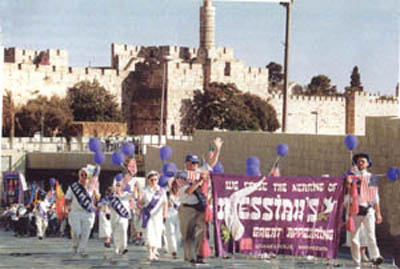 Various American Protestant sects have become ardent supporters of Judaism. Above, a demonstration by Evangelicals in Jerusalem "lobbying" for the coming of the Jewish messiah... Is the Conciliar Church walking on the same path? - Le Monde des Religions, November-December 2003 |
Therefore, besides employing the expression “dear Hebrew friends and brothers” in his opening statement of his Allocution at the synagogue, (117) John Paul II further calls the followers of Caiphas “beloved brothers” and “older brothers.” With this, one sees that the Pontiff not only affirms a unity with them in the same religious profession, but also acts as if they have some “predilection” and “first-born rights” independent of the truths of the Catholic Faith.
How would it be possible for the Jews to enjoy the same “predilection” of Catholics if, as Scriptures clearly states, “without the Faith it is impossible to please God”? (Hebr. 11:6)
John Paul II’s mention of “older brothers” also appears to suppose a “right of the first-born” that present-day Jews would have over Catholics.
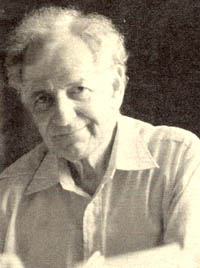 Fr. Bruno Hussar, founder of the Catholic-Hebrew Church Neve Shalom, which pretends to unify the two creeds. He drafted what Nostra aetate says regarding the Jews. Domenica del Corriere, July 7, 1984 |
“Now faith is the substance of things to be hoped for, the evidence of things that appear not ....Further on, the Apostle makes it clear that the faith of the ancient Patriarchs was the faith in Jesus Christ:
“By faith Abel offered to God a sacrifice exceeding that of Cain .... By faith Henoch was translated, that he should not see death .... By faith Noah, having received an answer concerning those things which as yet were not seen, moved with fear, framed the ark for the saving of his house, by which he condemned the world; and was instituted heir of the justice, which is by faith.
“By faith he that is called Abraham, obeyed to go out into a place which he was to receive for an inheritance; and he went out, not knowing whither he went. By faith he abode in the land .... By faith also Sarah herself, being barren, received strength to conceive ....
“By faith Abraham, when he was tried, offered Isaac .... By faith also of things to come, Isaac blessed Jacob and Esau. By faith Jacob dying, blessed each of the sons of Joseph .... By faith [Moses] left Egypt .... By faith he celebrated pasch .... By faith the walls of Jericho fell ....
“And what shall I yet say? For the time would fail me to tell of Gedeon, Barac, Samson, Jephthe, David, Samuel, and the prophets, who by faith conquered kingdoms, wrought justice, obtained promises, stopped the mouths of lions, quenched the violence of fire, escaped the edge of the sword, recovered strength from weakness, became valiant in battle, put to flight the armies of foreigners ....
“And all these being approved [by God] by the testimony of faith, received not the promise [immediately]; God providing some better thing for us, that they should not be perfected without us” (Heb. 11).
“Remember your prelates who have spoken the word of God to you; whose faith follow, considering the end of their conversation, Jesus Christ yesterday and today; and the same forever.” (Hebr. 13:7-8.)
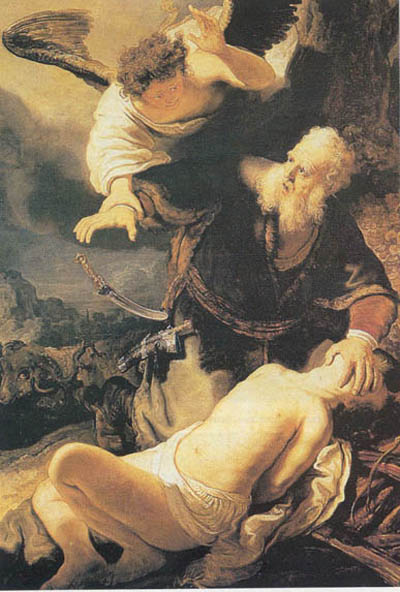 The alliance of God with Abraham was based on an act of faith. The alliance relies entirely, therefore, on fidelity to that same faith. Abraham's descendents are spiritual rather than racial. |
“Now in saying a new [covenant], he [God] has made the former old. And that which decayeth and groweth old, is near its end.” (Hebr. 8:13)
Thus, both as the substance of the continuity of the Old Covenant and as the foundation of the New, faith in Our Lord Jesus Christ is the basis of any predilection and the only grounds for the right of first-born.
Therefore, to speak of the “predilection” of the Jews in our day and attribute to them some religious right of first-born vis-à-vis Catholics, completely setting aside the question of Faith, is not acceptable. It seems either a clear denial of the Catholic dogmas and their base in Scriptures or a nonsensical declaration of the supremacy of the Jewish race over the others.
This analysis of the Pontiff’s words gives rise, in the mind of a Catholic faithful, to an appalling question: Could John Paul II make such statements without abandoning the Catholic Faith?
F. “No atavistic or collective guilt can be attributed to the Jews as a people for ‘that which was done in the Passion of Jesus.’ (NA, n. 4) .... Therefore, the pretended theological justification of discriminatory or persecutory measures is inconsistent”
The first objectionable thing that calls one’s attention in this reasoning is the inversion of the most elementary rules of logic. John Paul II takes as a premise the conclusion, and draws as a conclusion the abolition of premises.
Indeed, it is elementary in theological thinking that the obligatory premises are the data of Revelation coming from Sacred Scriptures and Tradition. If John Paul II intended to exempt the Jews from the guilt of the crime of Deicide, he should have based himself on passages from Holy Scripture that would permit him to make such a defense. Or, in the absence of such foundations, he should have based himself on elements provided by Tradition. Now then, to buttress this unprecedented “absolution” of the Jews, the Pontiff fails to present any basis from the sources of Revelation.
To make this extremely serious dogmatic judgment, he invokes only two points that do not constitute per se a solid basis for an argumentation: the notion of “mystery” and the conciliar Declaration Nostra aetate (n. 4). The notion of mystery is unclear, as the very word indicates, and does not allow a conclusion of this gravity. The text of Nostra aetate is likewise inadequate, since it also fails to present data from Sacred Scripture or Tradition to justify the “absolution” of the Jews. Therefore, for all practical purposes, to cite the conciliar Declaration has the value of a petition of principle (118), which amounts to saying that it is devoid of value.
Thus, John Paul II took as a premise what should have been the conclusion of his argument.
From this defective premise, he draws, as a conclusion, the disconcerting affirmation that “therefore, the pretended theological justification of discriminatory or persecutory measures is inconsistent.” What does John Paul II really mean by this conclusion? What is in the “inconsistent” justification he is speaking about? Is he perchance referring to the excerpts from Sacred Scriptures that clearly speak about the crime of Deicide as having been committed by the whole people and thereby justify considering the Jews guilty? (119) If so, are we witnessing the revocation of Sacred Scriptures? Would a Pope have the power to contradict Revelation?
Further, why would he consider everything that the Popes, Councils, Fathers, Doctors, and Saints of the Church have taught throughout the centuries about the guilt of the whole Jewish people for the crime of Deicide as “inconsistent theological justifications”? Would such an assertion be a revoking of the centuries-old teaching of the Church? Again I ask: Does a Pope have such a power?
Given the bizarre “probative” method used by the Pontiff, a serious analysis of his statement would lead one to conclude that John Paul II’s act was just an abuse of authority lacking any theological foundation. It should simply be accepted as a despotic act by a Pope who justifies his position by saying: you have to accept it because I am the stronger, quia nominor leo... (120)
If this hypothesis is correct, such an act would be a tyrannical imposition of the inter-religious dialogue with Jews taken to such a paroxysm that it annuls the very foundations of the Catholic Faith. Oddly enough, this inter-religious dialogue was first presented as an overflowing of the mercy of the Church. This curious mercy toward the Jews would thus have led the Progressivist Church to anathematize the whole past of the Catholic Church. Thus do the steps of dialogue go from dialogue to anathema... (121) What a curious paradox!
G. “It is not licit to say .... that the Jews are ‘reprobates or accursed’”
Here, the imperative nature of John Paul II’s aims appears unequivocally. Non licet... It is not licit... An unjustified prohibition is the consequence of the previous illogical and despotic anathema.
It would have been very useful for the Pontiff to have explained to Catholics how his statement could harmonize with St. Paul’s words about the Jews:
“But Israel, by following after the law of justice, is not come unto the law of justice. Why so? Because they sought it not by faith, but as [if] it were [possible] of works. For they stumbled at the stumbling stone, as it is written: Behold I lay in Zion a stumbling stone and a rock of scandal” (Rom. 9:31-33).
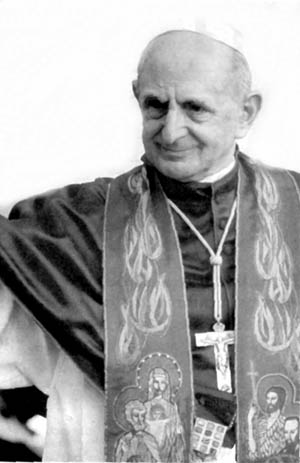 Paul VI wears the symbol of the Hebrew high priest, the rational of the judgment, the small square pendant hanging from his stole. It is inlaid with 12 precious stones that represent the 12 tribes of Israel. 30 Dias, May 1994 |
“That which Israel sought he hath not obtained; but the election [by God] hath obtained it; and the rest have been blinded [by their malice], as it is written: God hath given them the spirit of insensibility; eyes that they should not see; and ears that they should not hear, until this present day.St. Paul is also clear when he speaks about the Jews who left the Church after having converted:
“And David saith: Let their table be made a snare, and a trap, and a stumbling block, and a recompense unto them. Let their eyes be darkened, that they may not see; and bow down their back always [under the weight of the law]” (Rom. 11:7-10).
“For if we sin willfully after having the knowledge of the truth, there is now left no sacrifice for sins, but a certain dreadful expectation of judgment, and the rage of a fire which shall consume the adversaries [of God]. A man making void the law of Moses [by becoming an idol-worshiper] dieth without any mercy under two or three witnesses; how much more do you think he deserveth worse punishments, who hath trodden underfoot the Son of God, and hath esteemed the blood of the testament unclean, by which he was sanctified, and hath offered an affront to the Spirit of grace?The following excerpt from the Epistle to the Hebrews also opposes the desire to exempt the Jews from God’s curse:
“For we know him that hath said: Vengeance belongeth to me, and I will repay. And again: The Lord shall judge his people. It is a fearful thing to fall into the hands of the living God.” (Hebr. 10:26-31)
“For it is impossible for those who were once illuminated, have tasted also the heavenly gift, and were made partakers of the Holy Ghost, have moreover tasted the good word of God, and the powers of the world to come, and [afterward] are fallen away; [it is impossible for them] to be renewed again to penance, crucifying again to themselves the Son of God, and making him a mockery. For the earth that drinketh in the rain which cometh often upon it, and bringeth forth herbs meet for them by whom it is tilled, receiveth blessing from God. But that which bringeth forth thorns and briars, is reprobate, and very near unto a curse, whose end is to be burnt.” (Hebr. 6:4-8)The anathema by John Paul II clearly clashes with these and many other passages of Holy Scriptures.
The Pontiff closed the core of his Allocution emphasizing the points I have just analyzed and announcing that his anathema against the previous teaching of the Church has a perennial character:
“On the occasion of this visit to your synagogue, I want to reaffirm and proclaim their [the above analyzed phrases] perennial value. This is, therefore, the meaning that should be attributed to my visit to you, Jews of Rome.” (122)4. The Jews reaffirm their false convictions
However bewildered these words of John Paul II may leave the mind of a Catholic, they nevertheless express only part of the reality: the desire of the Pontiff to abandon the 2,000-year-old position of the Catholic Church toward the errors of the Jewish religion. Another facet of the reality is the ceremony – the hymns and psalms – with which the rabbis received John Paul II, as well as the speeches by Jewish representatives. Let me now analyze these symbolic acts.
A. Passages from Scriptures, hymns, and psalms
sung by the Jews at the reception of John Paul II (123)
Since this was the first time in History that a Pope visited a synagogue, the ceremonies made by both parties are particularly symbolic. This is especially so if we bear in mind that the Hebrew people, by character, are prone to express their thoughts and feelings much more through metaphors and symbols than discursive and systematic expositions. Moreover, since the greatest clash between religious convictions the world has ever seen is the struggle between the Faith of Our Lord Jesus Christ and the false faith of the Jews, it seems indispensable to analyze the ceremonies held during the visit of John Paul II to the synagogue of Rome in order to realize what Jewish intentions are toward Holy Mother Church. (124)
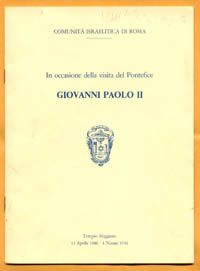 Cover of the booklet distributed to the Jews in the synagogue for John Paul II's visit. It is written in Italian and Hebrew. |
“After these facts the word of the Lord was directed to Abraham in a vision, in these terms: ‘Do not be afraid Abraham, I am your shield; the reward you will receive will be very large.’
“And Abraham said: ‘Lord God, what will You give to me? I am alone; the inheritor of my house is Eliasar from Damasco.’ He added: ‘Thou did not give me a descendant, my domestic servant will be my heir.’
“The Lord answer him immediately: ‘Your heir will not be him, but one who will come from your body.’ He led him outside and said: ‘Look at the sky and count the stars, if you can.’ And added: ‘As numerous as they will be your descendents.’
“He had faith in the Lord who increased his merit. Thus the Lord said to him: ‘I am the Lord who took you from Ur-Casdim to give you this land.’” (125)
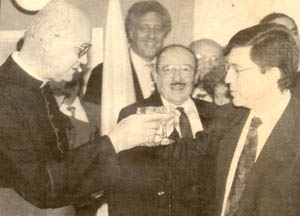 TOASTS Above, on December 30, 1993, representatives from the Vatican and Israel toast after official diplomatic relations were established. In practical terms, this means that the Holy See recognizes Israel as a legitimate State. Below, commemorating the occasion, rabbi Henry Sobel kisses Cardinal Arns in Sao Paulo. 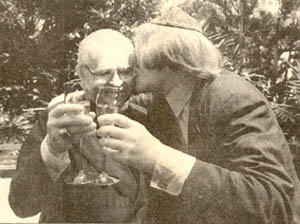 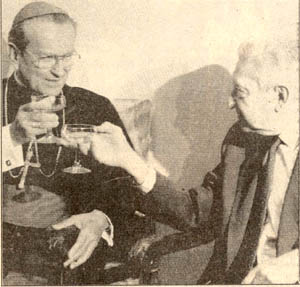 Photos from Estado de Sao Paulo, December 31, 1993; January 1, 1994; August 17, 1994 |
Rabbi della Rocca immediately went on to read the text of Micheas (4:1-5) that ends with this passage, which the Jews apply to themselves:
“For the peoples will walk every one in the name of his god; but we will walk in the name of the Lord our God forever and ever” (Mic. 4:5).
Reciting this excerpt in the presence of John Paul II, the visible head of the Catholic Church, is to strongly insinuate that Catholics – a "people” other than the Jews – do not worship the true God; rather, the Jews do. Again, the intention here appears to be to insult Jesus Christ and the dogma of the Trinity – whose Persons for the Jews are false gods – and to reaffirm their ancient errors.
What did John Paul II do after this insult and the speeches which will be analyzed below? He recited Psalm 133 (132 of the Vulgate) exalting the joy of brothers who live together in unity.
Responding to this anodyne joy of John Paul II, the chief rabbi read Psalm 124 (123 of Vulgata) which reveals Jewish resentments: Catholics are implicitly viewed as enemies of God, unjust and bestial persecutors of the Israelites, who are the true faithful protected by the Lord. The Jewish booklet reads:
“If the Lord were not for us, let Israel now say; if the Lord were not for us, when men rose up against us, probably they would have swallowed us up alive. When their fury was enkindled against us, then the waters [of calamity] would have drowned us; a torrent would have passed over us; the impetuous waters would have passed over us.
“Blessed be the Lord, who has not given us to be a prey to their teeth. Our persons have been delivered as a sparrow out of the snare of the fowlers. The snare is broken, and we are delivered. Our help is in the name of the Lord, who made heaven and earth.”
Such allusions to alleged Catholic persecutions of the Jews, besides insulting, are unfounded, as was demonstrated above.
Having ended this violent metaphoric allusion with Psalm 124, implicitly blaming the Catholics for the persecutions they suffered, all the Jews present – about 1,500 – stood up to sing the hymn Ani Ma’amin (I believe), (127) their equivalent of a profession of faith.
With this, the offense to the honor of the Holy Church reached its apex. True Faith in Jesus Christ was implicitly denied by a Vicar of Christ, present in the synagogue to assist at a profession of the false faith of those who are heirs to the Deicide and whose relentless design is to destroy Holy Mother Church.
After chanting the Ani Ma’amin – which the Jews are said to have sung as they were led to Nazi extermination camps (128) – those present observed one minute of silence for the victims of Auschwitz. The timing of this act casts an even less favorable shadow on the alleged persecutions by Catholics. Indeed, it would seem that the organizers of the ceremony were trying to blame the Holy Church for the Nazi massacres, or at least liken the persecutions waged by the neo-pagan National-Socialism to those allegedly carried out by Catholics.
Underlying this ceremony, one again notes a desire to offend the Church. This was followed by the singing of psalm 16 (15 of the Vulgate), which reads:
“Their sorrows were multiplied, those who follow strange gods. I will not share the blood of their offerings, nor will I pronounce their names with my lips” (Ps. 16:4).Since the Jews deny the divinity of Our Lord Jesus Christ and the Most Holy Trinity, such affirmations by rabbis and Jews were certainly meant for Catholics – “those who follow strange gods.” After this affront, each one repeated: “Nor will I pronounce their names with my lips.” Therefore, the recognition of Jesus Christ and the Holy Trinity, as well as the possibility of conversion are out of the question. Incidentally, the Jews made sure to avoid the least mention of Our Lord’s name throughout the ceremony.
They continued with the psalm by alluding to the false idea that the inheritance of the present-day Jews is the true inheritance of God:
“The Lord is the portion of my inheritance and of my cup; it is thou that holds in thy hand my part” (Ps. 15:5).The psalm ended with a text applying to the errors of the synagogue signifying that the latter follow the true ways of the Lord leading to eternal happiness. This would indirectly amount to intoning victory over the Church, the sole means to attain life eternal:
“Thou hast made known to me the ways of [immortal] life; thou shalt fill me with joy with thy countenance; at thy right hand are delights even to the end” (Ps. 15:11).
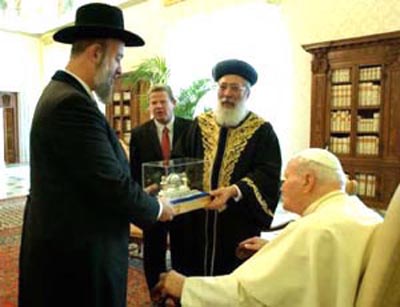 In January 2005, in his library at the Vatican, JPII receives a reward from Israeli rabbis for his constant support for the Jewish religion National Catholic Reporter, January 30, 2005 |
As the chanting of Psalm 16 (15 of Vulgate) drew to an end, John Paul II and the chief rabbi embraced each other once again, and then left for a private meeting. The newspapers and magazines covering the event did not report what might have taken place on this occasion.
During the ceremony, John Paul II received a copy of the Torah, a sacred book of the Jews, and a menorah, a seven-branch candelabrum.
The ceremony ended, according to booklet distributed in the synagogue, with the text of a brief profession of “faith” that the Jews chanted together. I think it was a simplified formula of a longer profession of “faith,” the above-mentioned Ani Ma’amin that had already been sung. Here are the words of the canticle, as recorded in the Jewish booklet, chanted by the Hebrew choir as John Paul II was leaving the synagogue:
“I believe with perfect faith in the coming of the Messiah!The insult to Our Lord Jesus Christ is blatant. By chanting this at the end of the ceremony, the Jews categorically denied that Christ is God and the Messiah, and reaffirmed the old errors of their religion. If they thus affront the Word Incarnate, one can only imagine how scornfully they look on the Pope, the Vicar of Christ.
“And even if he takes a long time coming, I will wait every day until he comes!”
After leaving the synagogue, John Paul II embraced the chief rabbi for a third time.
In brief, the consequences of these psalms and hyms said in the synagogue in the presence of the Supreme Pontiff of the Catholic Church were:
* The implicit reaffirmation, by the Jews, of their doctrinal errors, namely the negation of the divinity of Jesus Christ and the Most Holy Trinity.Finally, as an aggravating factor it should be noted that following customary Vatican procedures, this ceremony must have been prepared beforehand and agreed upon by competent organs of the Holy See. That is, the Vatican and probably also the Pope knew beforehand that these affronts would be made and approved them.
* The symbolic reaffirmation that they are the only true followers of God.
* The actual affirmation of numerous, thinly-veiled insults cunningly made against the Holy Church and Catholics: that Catholics follow false gods, foster a torrential furor against Jews, are beasts whose teeth grind the Jews as their prey, were accomplices of the Nazi persecutions, and so on.
B. The speeches of the rabbis
The opening greeting to John Paul II by the representative of the Hebrew community of Rome, rabbi Giacomo Saban, also had an arrogant tone with veiled slights and offenses. The following points should be noted:
* In passing, the rabbi pejoratively called the Christian era the “vulgar era:”
“Soon after the end of the first millennium of the Vulgar Era .... a son of this community in Rome .... wrote the l’Arukh, the first compendium of norms of the Hebrews in the Diaspora.” (129)* He claimed that Vatican II drew the Catholic Church closer “to the faith of Israel,” although he refused to call the Catholic Faith by its name, referring to it instead as “the faith of the world”:
“Nostra aetate, one of the Council’s documents, the one that most closely has to do with us, introduces a different relationship between the faith of Israel and that of the world which surrounds us, restoring to us not only what was denied us through the centuries, but also the dignity to which we have always been entitled.” (130)* He made the recognition of the State of Israel by the Holy See a condition for taking the next step in the “fraternal dialogue” proposed by Nostra aetate:
“I believe I should manifest the hope that some hesitation regarding the State of Israel be dropped. The land of Israel, emotionally and spiritually, has a central place in the heart of every Jew, and a change of attitude in this matter would please not only those present here, but the whole Judaic world as well .... This would be, therefore, a further step in the 'fraternal dialogue' of which Nostra aetate speaks. .... I do not hesitate to believe that this will be done.” (131)
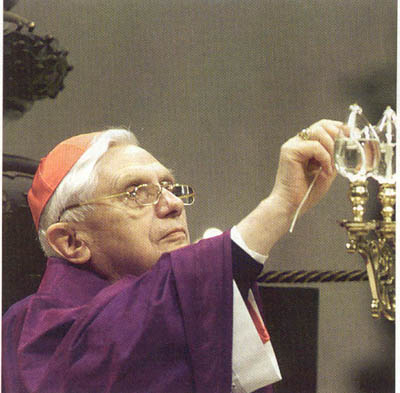 On March 12, 2000, Cardinal Ratzinger lights a seven-branch candelabra to ask forgiveness for the past "sin" of Catholic militancy. This included the Catholic combat against the Jewish religious errors. Inside the Vatican, January 2001 |
In a later speech by chief rabbi Elio Toaff, the following reaffirmations of the false Jewish faith and more insults to the Holy Church and the Catholic Faith should be pointed out:
* He called the Church’s 2,000 year-old policy toward the Jewish errors an “inadmissible teaching of scorn":
“We find ourselves, therefore, facing a true and authentic turnaround in the policy of the Church, which already looks to Jews with feelings of esteem and respect, abandoning that [former] teaching of scorn, the inadmissibility of which Jules Isaac .... called to the attention of Pope John.” (133)
* He affirmed the unshakable “fidelity” of the Jewish people to their false faith throughout History, which supposedly would make them the last surviving people of the Ancient World. It is noteworthy that this self-praise of Judaism as a religion, expressed immediately after the insolent criticism of the conduct of Holy Church toward Jews, transcribed above, clearly implies that the Jewish “martyrs” were victims of the Church’s “teaching of scorn.” He said:
“In the historic moment in which we are living, my thoughts turn with admiration, recognition, and sorrow to the infinite number of Jewish martyrs who serenely faced death for the sanctification of the Name of God. To them is owed the merit for the fact that our faith has never wavered and that fidelity to the Lord and to His Law never diminished as centuries passed. Due to this merit, the Jewish people still lives, unique among all the peoples of antiquity.” (134)* He proposed spreading the Jewish errors as a way to achieve the pacifist and inter-confessional longings of John Paul II:
“We propose to disseminate Israel’s idea of moral and spiritual monotheism in order to unite men and the universe in love.” (135)* He also made veiled mention of the gnostic Jewish doctrine of the Eternal Feminine [click here]:
“At the same time, we reaffirm the universal paternity of God over all men, drawing our inspiration from the prophets who taught that this filial love unites all living beings in the maternal bosom of the infinite as in its natural matrix.” (136)* Again, he insisted that the State of Israel be recognized, thus proclaiming the religious-messianic-hegemonic role that the Jews attribute to it:
“The return of the Hebrew people to their land must be recognized as a good and irrevocable victory for the world, for this is a prelude .... to that epoch of universal fraternity to which we all aspire, and to that redeeming peace whose firm promise is found in the Bible. The recognition of this unique function of Israel in the plan of final redemption promised by God cannot be denied.” (137)So, the speeches of the rabbis in the presence of John Paul II constituted a categorical reaffirmation of their old errors, aspirations, and insults against the Church.
5. Conclusion of this analysis
The conclusion to the analysis of this visit, in my view, is clear and painful. John Paul II went to the synagogue of Rome for these purposes:
* to try to annul the foundation in Revelation for the crime of Deicide;In contrast, the rabbis, explicitly in their speeches and symbolically in their recitation of psalms and passages from the Bible, made this arrogant retribution:
* to condemn the wise 2,000-year-old conduct of Holy Mother Church in relation to the Jews;
* to praise their false faith and anathematize whomsoever should criticize or censure the followers of Caiphas from the religious standpoint.
*they insistently reaffirmed their false faith;This is what was accomplished during the visit of John Paul II to the synagogue of Rome. ”Qui habet aurem, audiat...” [He that hath an ear, let him hear, Apoc. 2:7]
* they condemned the historic attitude of the Church;
* they insulted the honor of the Church and Catholics;
* they proclaimed the need for Jewish hegemony over the whole world,
* they demanded that the Holy See recognize their State, to which they attributed a messianic destiny.
1. Giuseppe De Rosa, “Ebrei e cristiani ‘fratelli’ nel ‘fratelo’ Gesù,” La Civiltà Cattolica, May 3, 1986, p. 261.
2. Ibid., p. 260.
3. Il Giornale, April 13, 1986, apud Giovanni Caprile, “Il Papa al tempio ebraico di Rome,” La Civiltà Cattolica, May 3, 1986, p. 267.
4. Ibid., p. 264.
5. Broadcast of Israeli Radio, apud G. Caprile, ibid., p. 265.
6. Giacomo Saban, Opening Speech, L’Osservatore Romano, April 14-15, 1986, p. 5.
7. Elio Toaff, Speech addressed to John Paul II, L’Osservatore Romano, April 14-15, 1986, p. 5.
8. John Paul II received a standing ovation when he alluded to the supposed guilt the Church would have for her attitude toward Judaism throughout the course of History. Carlo de Lucia, “Cari amici e fratelli ebrei e cristiani...,” L’Osservatore Romano, April 14-15, 1986, p. 5.
9. John Paul II, Allocution at the synagogue of Rome, L’Osservatore Romano, April 14-15, 1986, p. 4.
10. Dictionnaire Apologetique de la Foi Catholique (DAFC), col. 1726. 11. See also Epistulae IX, CIX, CX, cf. III, XXXVIII, apud ibid., col. 1744.
12. René Aigrain, L’Espagne chrétienne, Fliche & Martin, Histoire de l’Eglise despuis les origins jusqu’à nos jours, Paris: Bloud & Gay, 1946-1960, vol. 5, p. 246
13. Auguste Dumas, Le sentiment religieux et ses aberrations, ibid., vol. 7, p. 463.
14 See also the letters of Jan. 16, 1205 to the King of France and of Jan. 10, 1208 to the Bishop of Auxerre
15. A. Fliche, La réforme de l’Eglise, Fliche & Martin, Histoire de l’Eglise, vol. 10, p. 142.
16. F. Vernet, Juifs et Chrétiens, DAFC, col. 1691; Christine Thouzellier, L’enseignement et les universités, Fliche & Martin, Histoire de l’Eglise, vol 10, pp. 379-380.
17. F. Vernet, Juifs et crétiens, ibid.
18. Registres d’Innocent IV, vol. 1, n. 682, Potthast, 11376, Chartularium, n. 131, ibid. vol. 1, nn. 173, 178; Saint Louis et Innocent IV, pp. 302-6, apud C. Thouzellier, L’enseignement et les universités, p. 380.
19. F. Vernet, Juifs et Chrétiens, col. 1739.
20. Ibid., col. 1692.
21. Ibid.
22. Ibid.
23. Ibid., col. 1740.
24. Ibid., col. 1728.
25. Bernardino Llorca, Bulario Pontificio de la Inquisición Española, Rome: Pontificia Università Gregoriana, 1949, pp. 106-8.
26. Arm. XXXIX, vol. 31, 1518, n. 48, and to the Doge, Arm. XL, vol. 3, n. 331, Vatican’s Secret Archives, apud Ludovic Pastor, Historia de los Papas, vol. 8, p. 350.
27. Bull. VI, pp. 482-3, apud L. Pastor, Historia de los Papas, vol. 13, p. 208.
28. Bull. VI, p. 498, apud ibid., vol. 14, pp. 234-5.
29. See a report on this topic in Révue des Études Juives, XX, 68, Masio, Letters, 515, Berliner, II, 2, 7; Rodocanachi, 40-2.; see also Letters of Saint Ignatius, V, pp. 288-9, apud L. Pastor, Historia de los Papas, vol. 14, p. 236.
30. Caracciolo, Vita, 4, 11; Erler, Arquivo de Direito Canônico, L III, 49; Reusch, I, 48; Vogelstein-Rieger, II, 156-7; Berliner, II, 2, 8-9; see also same author, Censura y confisco de los libros judios en los Estados da la Iglesia, Frankfurt, 1891, apud L. Pastor, Historia de los Papas, vol. 14, p. 239.
31. F. Vernet, Juifs et Chrétiens, col. 1693.
32. Bull. Rom. VII, p. 740, apud L. Pastor, Historia de los Papas, vol. 17, p. 301.
33. F. Vernet, Juifs et Chrétiens, col. 1712.
34. Brief of May 3, 1569, apud Laderchi, 1569, n. 187.
35. Apud L. Pastor, Historia de los Papas, vol. 17, p. 306.
36. Ibid., vol. 17, pp. 306-7.
37. Ibid., vol. 19, p. 281.
38. F. Vernet, Juifs et Chrétiens, col. 1737.
39. L. Pastor, Historia de los Papas, vol. 19, p. 282.
40. Reusch, I, 50, 333, 339, 534.
41. See in Sixtus of Siena (a converted Jew), Bibliotheca sancta, Paris, 1610, pp. 310-1; see the list of books that he destroyed in Cremona; F. Vernet, Juifs et Chrétiens, col. 1738.
42. L. Pastor, Historia de los Papas, vol. 24, pp. 111-2.; F. Vernet, Juifs et Chrétiens, col. 1731.
43. Epist. V, Vatican’s Secret Archive, L. Pastor, Historia de los Papas, vol. 28, p. 285.
44. F. Vernet, Juifs et Chrétiens, col. 1694.
45. Analecta juris pontificii, Rome, 1860, pp. 1422-3.
46. F. Vernet, Juifs et Chrétiens, col. 1694.
47. Henri Delassus, La conjuration antichrétienne, Lille: Desclée de Brouwer, 1910, vol. 1, p. V.
48. H. Delassus, La conjuration antichrétinne, vol. 3, p. 1157.
49. Ibid.
50. F. Vernet, Juifs et Chrétiens, col. 1734.
51. H. Delassus, La conjuration antichrétinne, vol. 3, p. 1157.
52. R. Aigrain, L’Espagne Chrétienne, Fliche & Martin, Histoire de l’Eglise, vol. 5 p. 238.
53. H. Delassus, La conjuration antichrétinne, vol. 3, pp. 1157-8.
54. R. Aigrain, L’Espagne Chrétienne, Fliche & Martin, Histoire de l’Eglise, vol. 5, p. 241.
55. Ibid., pp. 245-6.
56. Ibid., p. 259.
57. H. Delassus, La conjuration antichrétinne, vol. 3, p. 1158.
58. Terminus, canon 8, in Conciliorum Oecumenicorum Decreta, Rome: Herder, 1962, pp. 121-2.
59. Mansi, vol. 28, col. 79, apud A. Dumas, Le sentiment religieux et ses aberrations, Fliche & Martin, Histoire de l’Eglise, vol. 7, p. 463.
60. Jean Rousset de Pina, La politique italienne d’Alexandre III et la fin du schisme, ibid, vol. 9/2, p. 167.
61. Decret. II, XX, 21; F. Vernet, Juifs et Chrétiens, col. 1744.
62. A. Fliche, La réforme de l’Eglise, Fliche & Martin, Histoire de l’Eglise, vol. 10, p. 174.
63. Conciliorum Oecumenicorum Decreta, pp. 241-3.
64. 1892, 1.XXIV.
65. F. Vernet, Juifs et Chrétiens, col. 1741.
66. Session XIX, Decretum de Iudaeis et neophytis, Conciliorum Oecumenicorum Decreta, pp. 459-50.
67. F. Vernet, Juifs et chrétiens, DAFC, col. 1749.
68. Ibid., col. 1751-2.
69. Apud H. Delassus, La conjuration antichrétinne, vol. 3, pp. 1161-1162.
70. John Paul II, Allocution in the Synagogue of Rome, L’Osservatore Romano, April, 14-15, 1986, p. 4.
71. John Paul II appears to refer to the middle of chapter IV of Nostra aetate, which reads:
“True, authorities of the Jews and those who followed their lead pressed for the death of Christ (cf. John 19:6), but what happened in His passion cannot be blamed upon all the Jews then living, without distinction, nor upon the Jews of today. Although the Church is the new people of God, the Jews should not be presented as repudiated or cursed by God, as if such views followed from the Holy Scriptures. ....
“Indeed, the Church repudiates all persecutions against any man. Moreover, mindful of her common patrimony with the Jews, and motivated by the Gospel’s spiritual love and by no political considerations, she deplores the hatred, persecutions, and displays of anti-Semitism directed against the Jews at any time and from any source” (NA, § 4f-g).
72. Ibid.
73. Ibid.
74. John Paul II, Allocution in the Synagogue, L’Osservatore Romano, April 14-15, 1986, p. 4.
75. The word “holocaust" is often used, above all by progressivists and the media, to designate the barbarous slaughter of Jews carried out by the Nazi regime during World War II. It became a characteristic talisman-word, employed to create a climate of compassion and sympathy for the Jews, inappropriately comparing them to the first martyrs of the Church. The impropriety of this usage lies in the fact that the latter were martyred on behalf of the one true Catholic Faith, whereas the Jews practice a false religion. Further, the Nazi persecution waged against the Jews was of a racist character, whereas the one unleashed against the martyrs was clearly religious.
76. G. De Rosa, “Ebrei e cristiani ‘fratelli’ nel ‘fratello Gesù,’” La Civiltà Cattolica, May 3, 1986, p. 261.
77. Cicero, De Orat. book II, Chap. 9:36.
78. Nero’s favorite lover, Sabina Popea, was known to be sympathetic toward the Jews (Cf. Flavius Josephus, Vita, 3, Antiquitates iudaicae, XVIII-XX; Tacito, Hist., I, 22, apud J. Zeiller, Les premières persécutions. La législation impériale relative aux Chrétiens, Fliche & Martin, Histoire de l’Eglise, vol. 1, p. 290).
The Jews who frequented Nero’s palace, protected by Popea, are thought to have denounced the Christians as authors of the criminal fire. They spread the calumny that the minds of the Christians were filled with “ideas of heavenly vengeance, universal conflagration, and the destruction of the world” (Duruy, Histoire des Romains, Paris, 1882, vol. 4, p. 507, apud J. Zeiller, Les premières persécutions. La législation impériale relative aux Chrétiens, ibid.).
79. In his Commentary on the Holy Scriptures, Cornelius A Lapide asserts: “The first persecution waged by the pagans [against the Christians] was provoked by the Jews and through the Jews, who stirred up the pagans against the Christians” (in Apocalypsim II, 9).
80. J. Klausner, Jésus de Nazareth, pp. 54-5., apud J. Lebreton, Saint Jacques et Saint Jean, Fliche & Martin, Histoire de l’Eglise, vol. 1, p. 243.
81. In his first Apology (1:31), St. Justin states: “Barcochba ordered that the Christians – and only the Christians – undergo the most terrible tortures if they did not renege Jesus Christ and blaspheme against him” (XXXI, 6, apud J. Zeiller, La persecution sous les Flaviens et Antonins, Fliche & Martin, Histoire de l’Eglise, vol. 1, p. 310).
82. Tertullian, Adversus Gnosticos Scorpiace, PL 2, 166.
83. J. B. Pereira, Epístolas dos Apóstolos e Apocalypse, p. 638.
84. Martyrium S. Polycarpi, XII, XIII, XVII, XVIII, apud F. Vernet, Juifs et Chrétiens, col. 1658.
85. Passio S. Pionii, III-IV, XIII-XIV, ibid., col. 1658. See also Jacques Zeiller, Les grandes persecutions du milieu du IIIe. siècle et la période de paix religieuse de 260 … 302, Fliche & Martin, Histoire de l’Eglise , vol. 2, p. 149.
86. J. Zeiller, Le siège romain, Fliche & Martin, Histoire de l’Eglise , vol. 2, p. 405. 87. F. Vernet, Juifs et Chrétiens , cols. 1658-9.
88. St. Gregory Nazianzene, Oratio, v. 3, apud H. Delassus, La conjuration antichrétienne, vol. 2, p. 683.
89. Eusebius, De vita Constantini, III, XVIII, apud F. Vernet, Juifs et Chrétiens , cols. 1744, 1762.
90. Ibid., col. 1665.
91. G. Bardy, Atticus de Constantinople et Cyrille d’Alexandrie, Fliche & Martin, Histoire de l’Eglise, vol. 4, p. 157.
92. G. Bardy & L. Bréhier, L’expansion Chrétienne aux Ve. et VIe. siècles, Fliche & Martin, Histoire de l’Eglise, vol. 4, pp. 526-7. See also Rohrbacher, Histoire Universelle de l’Eglise Catholique, vol. 5, pp. 24-6, narrating the massacre of Christians in Nedjran and transcribing the letter sent by Dhu Nowas (or Dunaan) to the Arab sheik Almondar boasting of having killed 280 Catholic priests and inviting him to do the same in his territories.
93. F. Vernet, Juifs et Chrétiens, col. 1665; L. Bréhier, Les rapports entre Rome et Constantinople..., Fliche & Martin, Histoire de l’Eglise, vol. 4, pp. 73-75.
94. L. Bréhier, L’Ekthesis, la fin du Règne et la succession d’Héraclius (638-641), ibid., vol. 5, p. 141.
95. R. Aigrain, L’Espagne Chrétienne, ibid., vol. 5, pp. 260 and 266.
96. L. Brohier, La querelle des images jusqu’au Concile iconoclaste de 754, ibid., vol. 5, p. 446.
97. Raul Glaber, a medieval chronicler, notes that “the devil had decided to employ his favorite nation to turn the poison of his wickedness against the servants of the true Religion” (Historiae, III, VII). See also Adhemar de Chabannes, Chronicon, III, XLVII-LII, apud A. Dumas, Le sentiment religieux et ses aberrations, ibid., vol. 7, p. 464.
98. Epiphanius, Haer., 51.
99. Ibid., 55, 57, 62.
100. Ibid., 65-69.
101. Athanasius, Ep. ad Solit. Theodor., 1.lib. II, Haer. Fabul. in Paul Sam.
102. Bossuet, Oeuvres Complètes - Explication de l’Apocalypse, Paris: Berche & Tralin, 1885, vol. 1, pp. 298-300.
103. Bernard Lazare (1865-1903), a French writer and journalist, was born in Nimes and died in Paris. In collaboration with his cousin, he published the poem La fiancée de Corinthe and later, with other writers, Entrétiens politiques et littéraires. Holding largely anarchist and class struggle views, he wrote for the Mercure de France, Journal, Figaro, and other publications. In 1894 he published L'Antisémitisme, son histoire et ses causes, (Anti-Semitism, Its History and Causes); in it he described the Jewish role in the fostering of anti-Semitism.
With the outbreak of the Dreyfus affair in 1894, he entered the fight on behalf of Captain Dreyfus (Enciclopedia Universal Ilustrada, Espasa-Calpe). He became one of the main characters of the famous Dreyfus affair, which resulted in the demoralization of the Army and monarchist circles in France. As a sign of gratitude, the republican government erected a statue in his honor (H. Delassus, La conjuration antichrétienne, vol. 2, p. 684).
104. For more on the revolutionary process, see Plinio Corrêa de Oliveira, Revolução e Contra-Revolução, São Paulo: Chevalerie, 1993, Part I, Chap. III.
105. Bernard Lazare, L’Antisemitisme, son histoire, ses causes, apud H. Delassus, La conjuration antichrétienne, vol. 2, pp. 684-5.
106. H. Delassus, La conjuration antichrétienne, vol. 2, p. 685.
107. Ibid, p. 686.
108. Ibid.
109. Ibid.
110. Ibid., pp. 686-7.
111. B. Lazare, Antisemitism, its history and causes, New York: The International Library Publishing Co., 1903; repr. London: Britons Publishing Co., 1967, chap. 3. 112. See box
113. Procès-verbal des séances de l’assemblée des députés francais professant la religion juive, p. 169, etc., apud H. Delassus, La conjuration antichrétienne, vol. 3, pp. 1164-1167.
114. H. Delassus, La conjuration antichrétienne, vol. 3, pp. 1167-1168.
115. Everton Florenzano, Dicionario Italiano-Portugues: Svolta - turn, turnaround, change, transformation; Nicola Zingarelli, Il Nuovo Zingarelli – Vocabulario della Lingua Italiana: Svolta - 1. action of turning oneself around .... 3. figurative: important change: That discovery beckons a svolta in the history of science.
116. G. De Rosa, “Ebrei e cristiani ‘fratelli’ nel ‘fratelo’ Gesù,'” La Civiltà Cattolica, May 3, 1986, p. 262.
117. L’Osservatore Romano, April 14-15, 1986, p. 4.
118. Petition of principle, or tautological argument, is a proposition that pretends to be an explication or proof of something but only repeats in identical or equivalent terms what was intended to be proved. Ex: Nostra aetate absolved the Jews of the crime of Deicide because it said it absolved them from such a crime.
119. See the next item.
120. “Because I am the lion,” is a reference to an Aesop’s fable in which the lion obliges the other animals to obey him for no reason except by force. In other words, 'this is so because I want it to be and have the power to impose my will.'
121. The book by Roger Garaudy, From Anathema to Dialogue, was considered a milestone in the dialogue between the Vatican and Communism. Garaudy, a known French communist writer, praised conciliar Vatican policy for having left off the condemnations in order to open up to the modern world - as well as to the communists. Now, one sees the reverse side of the coin of the conciliar policy, which shows its draconian face.
122. L’Osservatore Romano, April 14-15, 1986, p. 4.
123. I analyze here only five of the seven Jewish rituals made during the visit of John Paul II to the synagogue of Rome. Excluded were Psalms 118 (117 in the Vulgata) and 150 (150 in the Vulgata), whose texts are anodyne.
Since I could not find a clear account of exactly which psalms were sung in the Catholic sources that I read – L’Osservatore Romano (April 14-15, 1986, p. 5), La Civiltà Cattolica (n. 3261, p. 273), and La Documentation Catholique (n. 1917, p. 433) – I entered into contact with the Synagogue of Rome, which provided me a copy of the bi-lingual booklet the Jews used in the ceremony. I am quoting, therefore, straight from this booklet. The following texts are my translations from the Italian.
124. Criterium of analysis: I do not intend here to take univocally the symbolic meaning of the ceremonies held by the Jews on the occasion of John Paul II’s visit to the synagogue of Rome as a doctrinal manifestation. As in any ceremony, the Jewish chants and psalms performed there reflect primarily the state of mind of those who arranged and carried out the program. In order to detect their state of mind toward Catholics, who were represented by John Paul II, a bit of a sense of propriety should suffice. With this, one can gauge the successive affronts made by the Jews to Catholics, as well as the reaffirmation of their errors. Therefore, the analysis to be made here of the doctrinal meaning underlying the symbolism of the ceremony is not intended to go beyond this criterium of common sense.
Possibility of conversion: Someone could object that I fail to contemplate the possibility that John Paul II was preparing a sagacious maneuver to convert the Jews, which is why he went to the synagogue. The answer is simple. Since the end does not justify the means, it is not possible for any Catholic, above all a Pope, to convey the impression that he is abandoning the Faith in order to achieve a hypothetical conversion of the Israelites. Further, John Paul II did not make the least mention that the Jews should renounce their false faith, nor did the Jews show the least propensity toward this. Therefore, in both the moral sphere and actual realm of facts, the objection lacks any foundation.
125. In ocassione della visita del Pontefice Giovanni Paolo II, Communità Israelitica di Roma, Templo Maggiore, 1896, p.2.
126. Hebrews 3, 6, 7, 8, 9, 11; Romans 2:25-29; 3:27-30, especially the excerpt: “For not through the law was the promise to Abraham, or to his seed, that he should be heir of the world; but through the justice of faith. For if they who are of the law be heirs, faith is made void, the promise is made of no effect” (Rom. 4:13-14);
Further on, in another passage St. Paul says: “For all are not (true) Israelites (heirs to the promises) that are of Israel. .... That is to say, not they that are the children of the flesh are the children of God; but they that are the children of the promise” (Rom. 9:6-8). Many other passages could be cited that affirm the same.
127. C. de Lucia, "Cari amici e fratelli ebrei e cristiani. . .," L’Osservatore Romano, April 14-15, 1986, p. 5. 128. Ibid.
129. Greeting by the President of Rome’s Israelite Community, L’Osservatore Romano, April 14-15, 1986, p. 5.
130. Ibid.
131. Ibid.
131. Ibid.
132. H. Delassus, La conjuration antichrétienne, vol. 3, Sionnisme, pp. 1233-48.
133. L’Osservatore Romano, April 14-15, 1986, p. 5.
134. Ibid.
135. Ibid.
136. Ibid.
137. Ibid.



